There is no doubt that for any wildlife enthusiast Namibia offers an opportunity to experience game viewing on a limited budget compared to other parts of Africa. I guess the time of year will greatly impact on the numbers and species and their ease of finding as we found to say nothing of tourist numbers and prices.
Our visit lasted 25 nights plus 2 in the plane. Others might not have the time or the money to extend the visit to that length and at a guess our trip cost something in the region of £6-6.5K so not exactly inexpensive but when compared to the original quote of £8k for 7 days guided camping in Botswana ( and that didn't include flights) it's a drop in the bucket. I continue to be staggered at the cost of packages. Typically it seems a 14 night stay in Namibia following a route resembling ours to a large degree would cost somewhere in the region of £11k for two, but then you are part of a larger group and you lose the independence to stop or go whenever you want. It is so easy to organise it all yourself too.
Could we have done it even cheaper? Possibly yes. We could have found alternative places to stay but that would have meant changing the routes, we could have cut our the trips but that would have reduced our pleasure. God forbid, we could have given up the evil drink but it's so inexpensive in Namibia it wasn't a consideration.
How about camping? Well, my brief searches don't seem to make it that much of a saving overall. The cost of hiring a Hillux type vehicle with a tent on top is expensive but with the reduced excess added it seems prohibitive and you are left sleeping in less than total comfort. In the wet season I would definitely advise to think twice. I would also consider that for 7 of our 25 nights we paid less than £50 per night for accommodation, the reduced excess camper insurance costs a lot more than that per day. Yes, places like Dolomite camp are fairly expensive and the alternative of camping in Olifantsrus is £135 cheaper per night so it's a case of swings and roundabouts depending on how you structure your visit.
So how about the downsides ?
Obviously the seasons impact on a variety of aspects but the only real downside I could think of for this particular trip is the photographic limitations of shooting largely from a vehicle. You are not allowed to get out of your car in the National Parks or drive off road. Very sensible but limiting. I guess that's why waterholes are an attraction as you are more likely to have the animals come to you.
I'm sure safari purists would be quick to discount mass tourism as they take their 90 minute turn to have a one on one with a Mountain Gorilla and I must admit, the photographic opportunities when you take an off road and out of vehicle experience appear to be considerably better and more rewarding. That said I hear tales of vehicles jockeying for places around a subject in places like the Mara Mara and having experienced similar in Yala NP,Sri Lanka it's not for me. True wilderness is becoming more difficult to find it seems, or maybe it isn't. Maybe the answer is to avoid the well publicised spots and head elsewhere.
Anyway, whatever your decision I hope I have helped in some small way in deciding on Namibia as a destination and given an insight on what can be achieved.
Good luck and safety in your travels wherever they take you.
Dave 2017.
The trials and tribulations of a wannabe wildlife photographer. Lots more photographs can be found on my website:- http://www.pbase.com/davidwilliamsphotography
Friday 7 April 2017
Namibia 2017 Part 24. Only 24 hours from home.
What a fabulous day we'd had for our last day at Swakopmund. Those that had warned us off from staying longer really have misjudged what's on offer locally. We could have gone on all sorts of activities from Go-karts to Camel rides, Dune boarding to hang gliding as well as the trips we did take. As for the weather? It was actually pretty good, better than we'd experience for most of the trip with sunshine most of the day.
Our apartment in Swakop had probably been the best value of any place we stayed and despite the fact they only had a smallish garden there were a surprising number of birds visiting, some were "lifers" too.
The Orange River White-eye
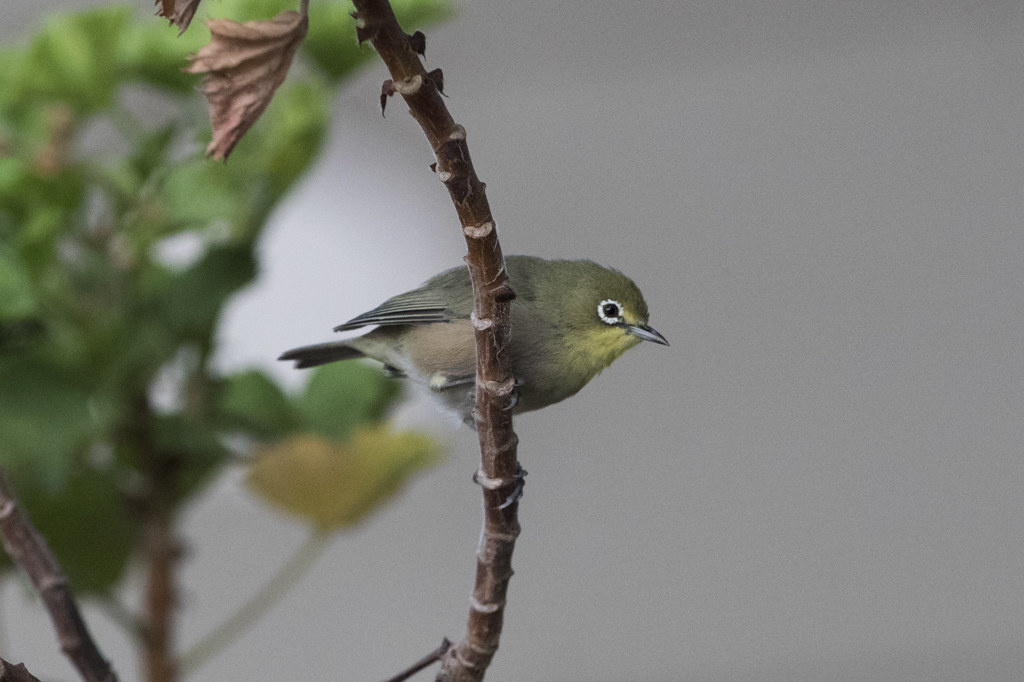
Cape Sparrow
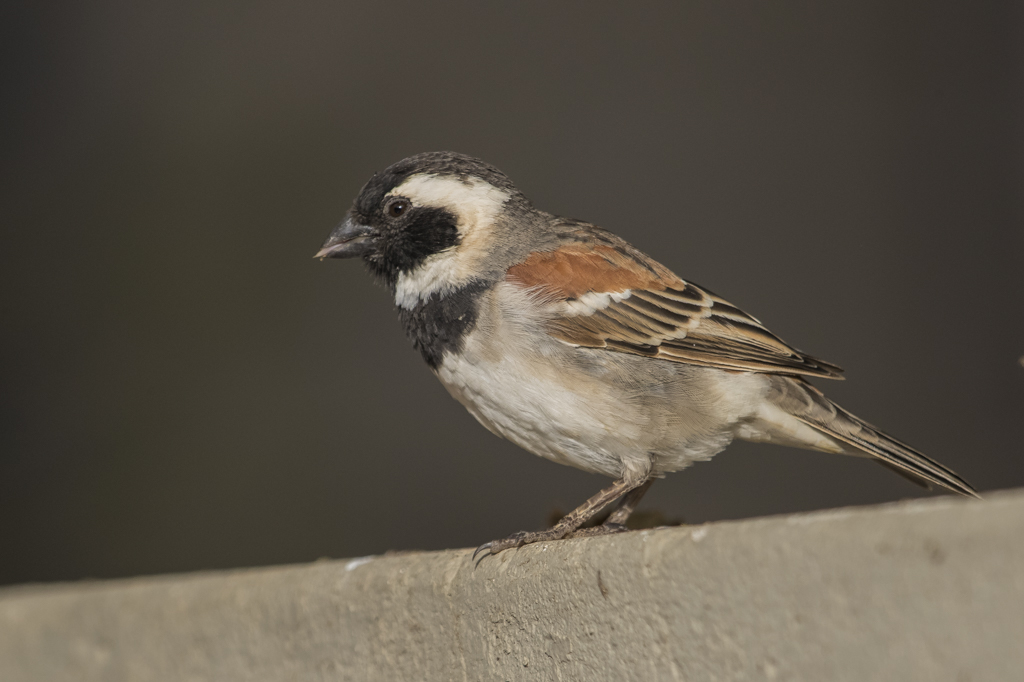
Common Waxbill
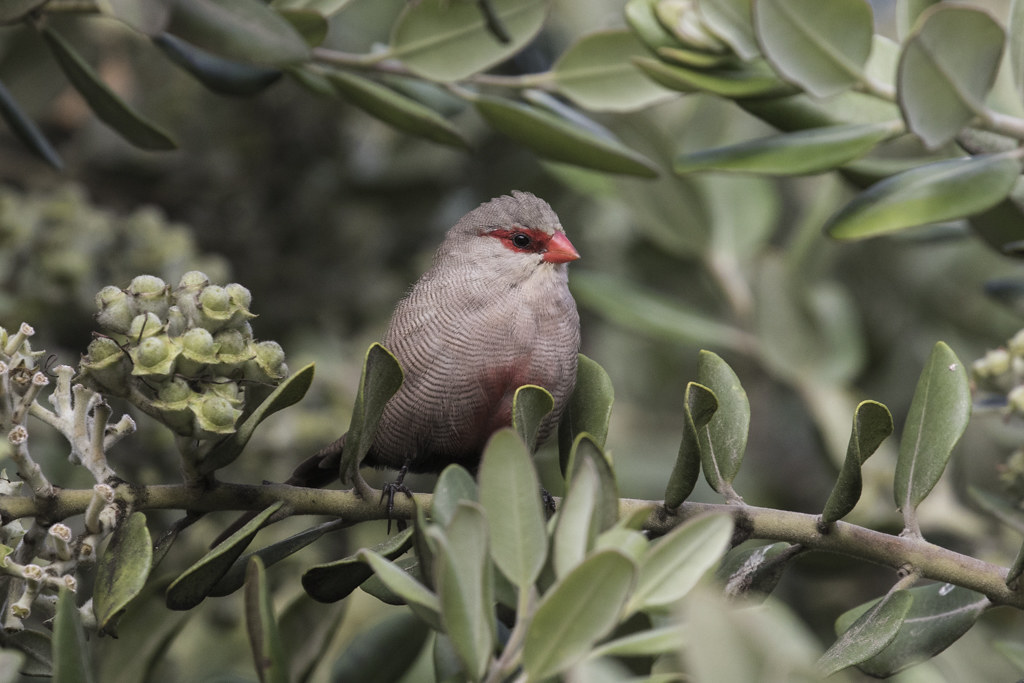
Others gave the best photo opportunities I'd had too.
House Sparrow
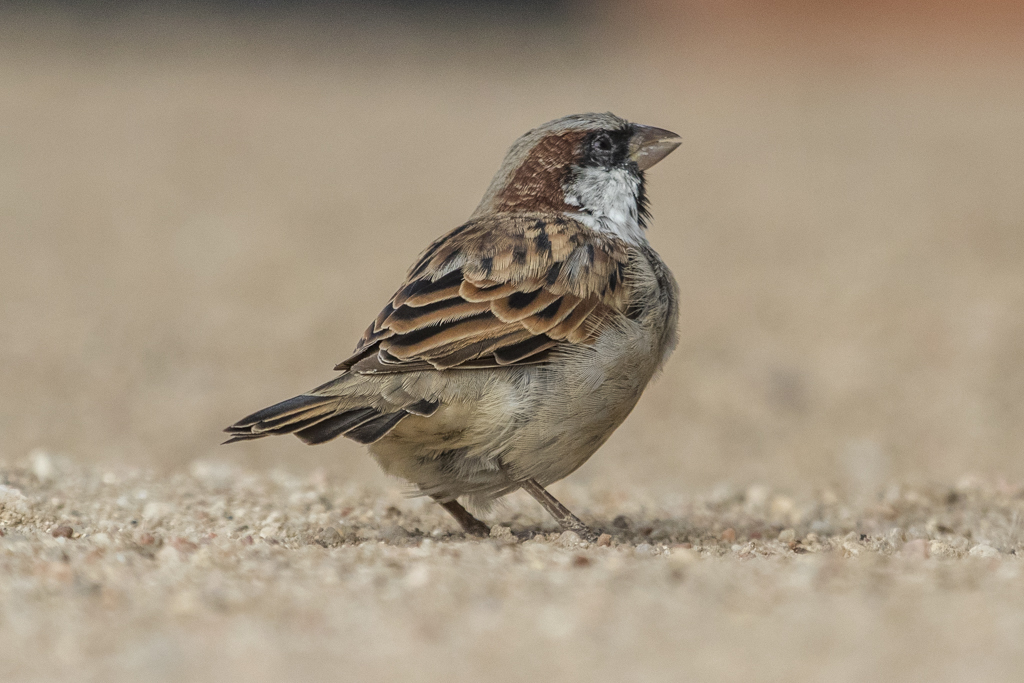
Laughing Dove

Cape Wagtail
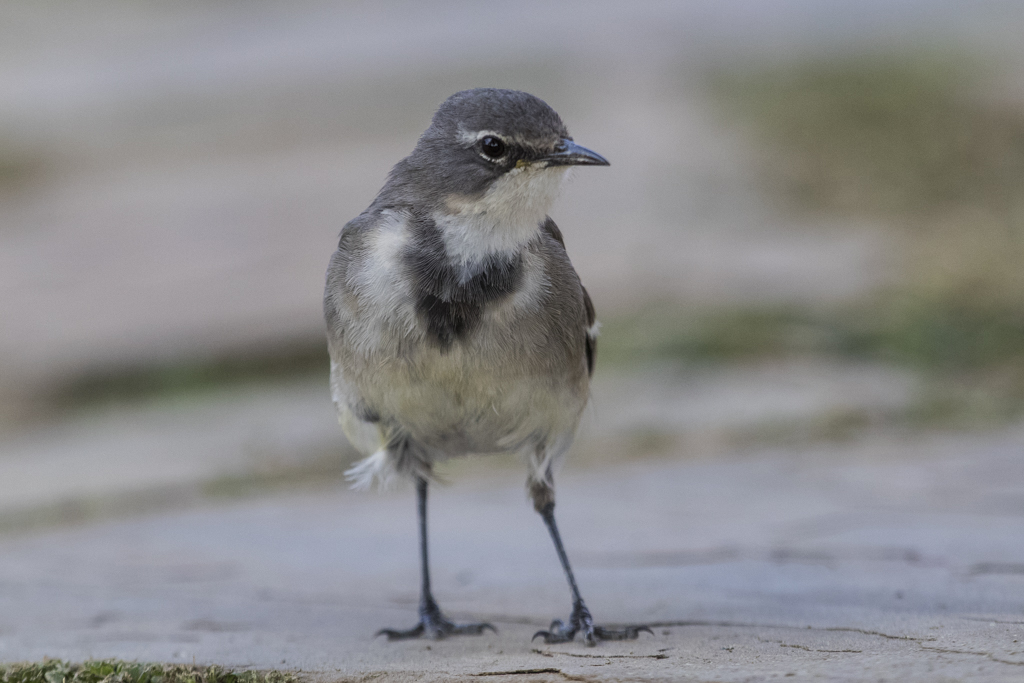
and I'm sure that if I'd spent more than a few minutes trying I could have got even better shots too.
Dusky Sunbird
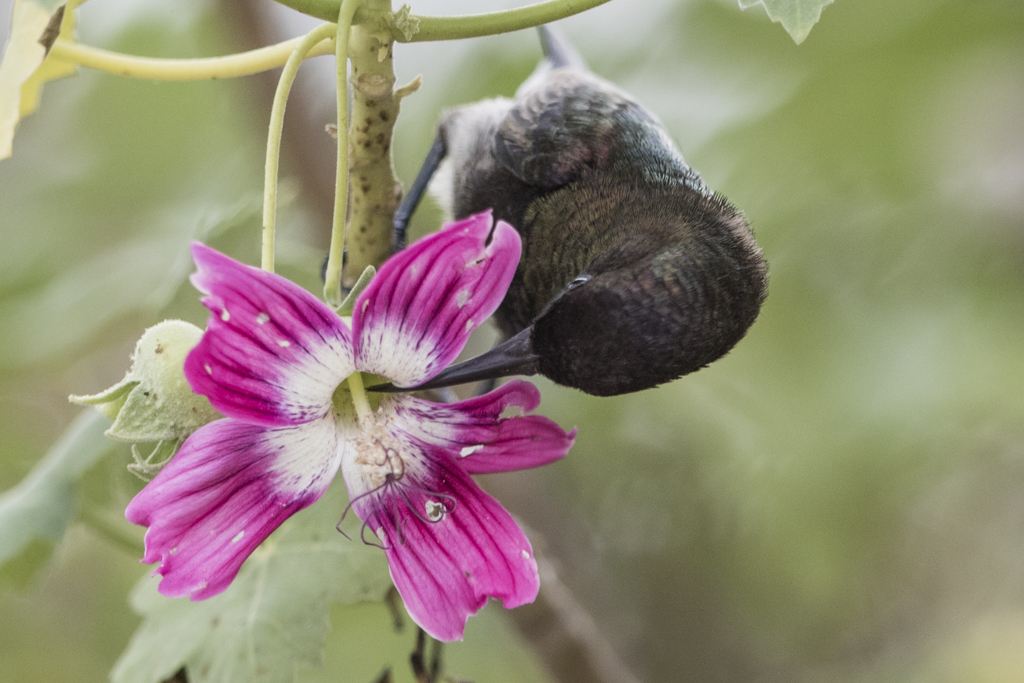
Too late now though, it was time to go.
We'd allocated a whole day to journey back to Windhoek and an overnight stay at our initial B&B before catching the flight back to the UK the following day. Rather than take the fast route I thought we could take the more scenic (?) C14 and C26 route rather than the B2.
It appeared few others choose this route!
For the first 100kms I doubt more than 2 cars passed in the opposite direction and in a journey of over 300kms in total perhaps no more than two dozen in total before reaching commuting distance of Windhoek.
The scenery was very varied through desert ( with an iPad)

and with my Olympus Tough.
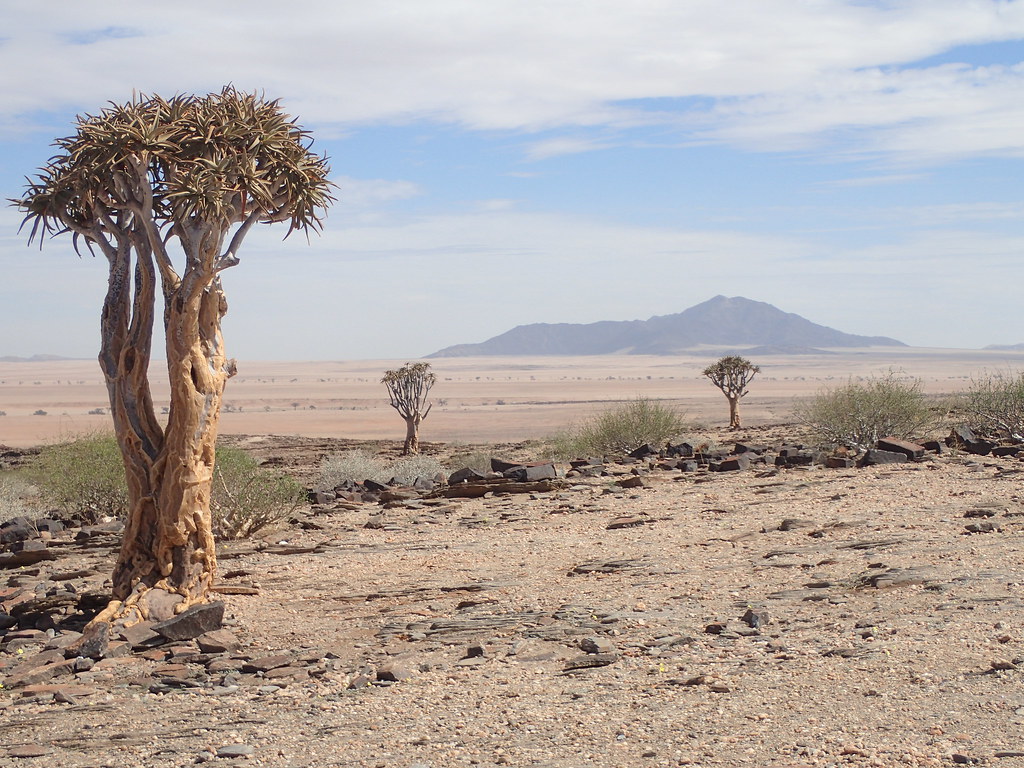
You travel over the mountains before reaching the somewhat parched farmlands beyond ( and our last sighting of game, albeit farmed).

Until you get to greener pastures.
Green means rain and we were about to get some!
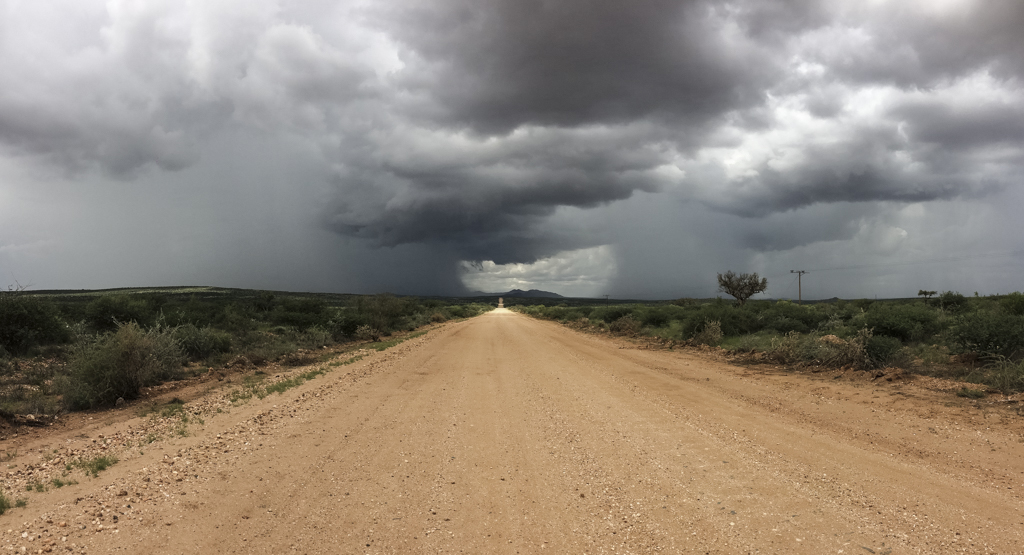
The rains in Namibia were badly needed so welcomed by us once again. All the wildlife benefited.
We had one last photo stop when I spotted my final new bird for the trip.

A rather bedraggled Southern Pied Babbler

and that was it.
Driving over the gravel roads our vehicle was totally bespattered with mud so we treated it to a car wash on the outskirts of Windhoek before heading back to the Sunshine Guesthouse and another evening meal at Joe's Beerhouse.
It was at Joe's we had our second remarkable meeting of the trip. Whilst staying the 4 nights at Etosha Village we met a lady that we recognised from our stay in The Gambia last November but here at Joe's the chance meeting was even more remarkable. We had called for our bill and were about to leave when I recognised the couple who were walking within 2 metres of our table but they hadn't noticed us. It was my son's "Best Man" and they had arrived in Namibia that day. Even stranger was he no longer lives in the UK but had been for a home visit the previous week and had been at my son's house a couple of days previously where he had been told we were in Namibia. Together they decided there was little point in trying to get in touch as we would no doubt be somewhere too distant to meet up but here we were , just a few feet away!
It's a small world sometimes. We spent an hour chatting before we headed home to bed and the airport the following day.
A lovely way to end our trip.
Our apartment in Swakop had probably been the best value of any place we stayed and despite the fact they only had a smallish garden there were a surprising number of birds visiting, some were "lifers" too.
The Orange River White-eye

Cape Sparrow

Common Waxbill

Others gave the best photo opportunities I'd had too.
House Sparrow

Laughing Dove

Cape Wagtail

and I'm sure that if I'd spent more than a few minutes trying I could have got even better shots too.
Dusky Sunbird

Too late now though, it was time to go.
We'd allocated a whole day to journey back to Windhoek and an overnight stay at our initial B&B before catching the flight back to the UK the following day. Rather than take the fast route I thought we could take the more scenic (?) C14 and C26 route rather than the B2.
It appeared few others choose this route!
For the first 100kms I doubt more than 2 cars passed in the opposite direction and in a journey of over 300kms in total perhaps no more than two dozen in total before reaching commuting distance of Windhoek.
The scenery was very varied through desert ( with an iPad)

and with my Olympus Tough.

You travel over the mountains before reaching the somewhat parched farmlands beyond ( and our last sighting of game, albeit farmed).

Until you get to greener pastures.
Green means rain and we were about to get some!

The rains in Namibia were badly needed so welcomed by us once again. All the wildlife benefited.
We had one last photo stop when I spotted my final new bird for the trip.

A rather bedraggled Southern Pied Babbler

and that was it.
Driving over the gravel roads our vehicle was totally bespattered with mud so we treated it to a car wash on the outskirts of Windhoek before heading back to the Sunshine Guesthouse and another evening meal at Joe's Beerhouse.
It was at Joe's we had our second remarkable meeting of the trip. Whilst staying the 4 nights at Etosha Village we met a lady that we recognised from our stay in The Gambia last November but here at Joe's the chance meeting was even more remarkable. We had called for our bill and were about to leave when I recognised the couple who were walking within 2 metres of our table but they hadn't noticed us. It was my son's "Best Man" and they had arrived in Namibia that day. Even stranger was he no longer lives in the UK but had been for a home visit the previous week and had been at my son's house a couple of days previously where he had been told we were in Namibia. Together they decided there was little point in trying to get in touch as we would no doubt be somewhere too distant to meet up but here we were , just a few feet away!
It's a small world sometimes. We spent an hour chatting before we headed home to bed and the airport the following day.
A lovely way to end our trip.
Thursday 6 April 2017
Namibia 2017 Part 23. In search of the Little 5!
Once again we had an early pick up at 7.00am, right on the agreed time and there were only two more people to collect and we were off to the sand dunes outside Swakopmund.
My original choice of tour operator had been fully booked for this our last day and in hindsight we were so lucky. Just four of us and as it turned out an extremely dedicated and excellent guide.
This was the company logo

Taken from the side of their vehicle and those are my sandals!
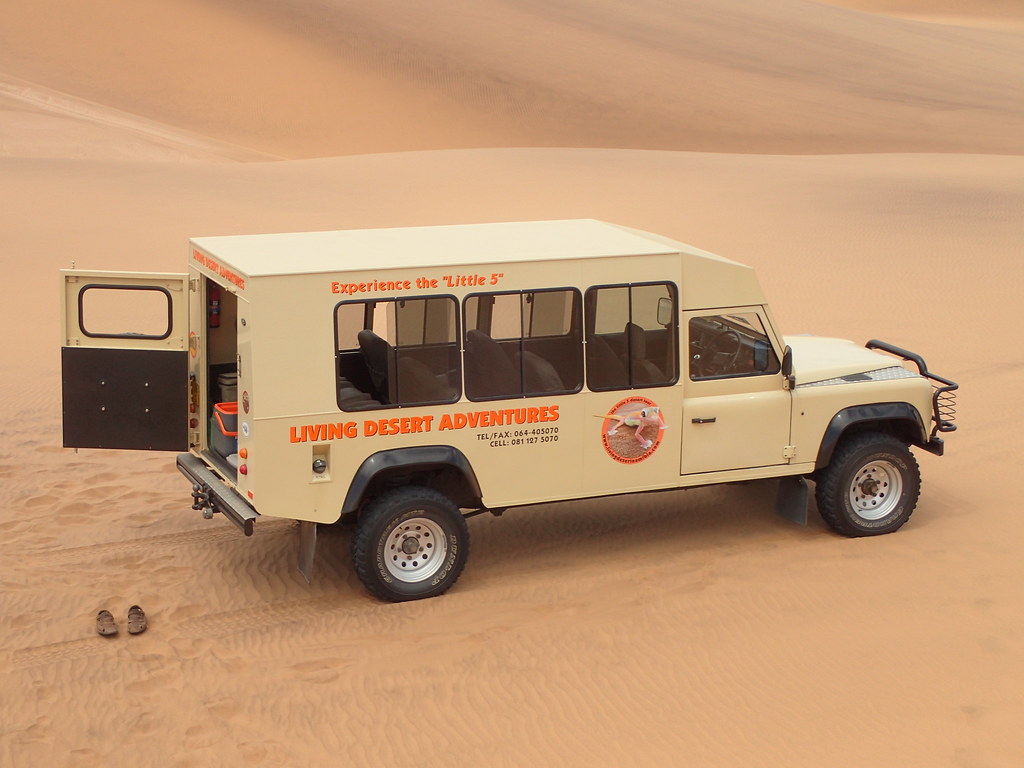
Loads of space, a guide between four of us, things looked much better than the other tour operators set up who we happened to pass. They were full to overflowing !
Would our guide measure up?
Well it certainly seemed so. He gave us an introductory talk about the deserts, the source of water from the sea mists, the moisture retaining plants and the "muesli" of seeds and plant fibres that blow about self seeding plants and providing food for a variety of creatures that make what seems an inhospitable environment their home.
I'll never look at sand dunes the same way again !
Look closely and you will be amazed at the number of tracks in the sand, each individual to the creature that left them. Our guide used them all to find our target species. He was better than Tonto ( if you are under a certain age you won't appreciate how good he was!)
First off he found us the endemic Palmato Gecko as shown on their logo.
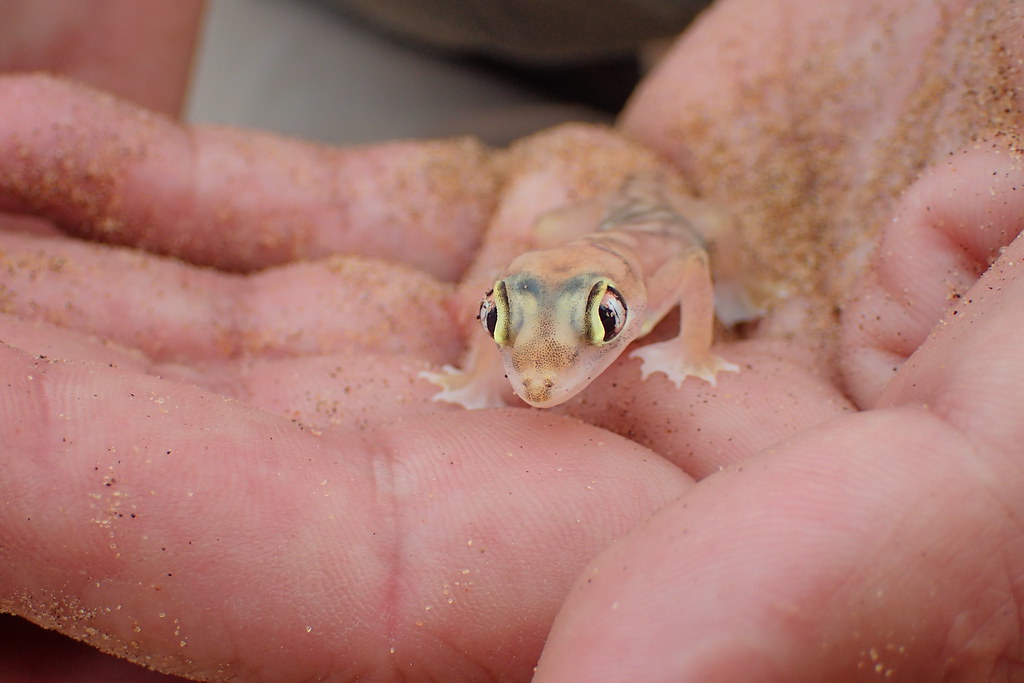
He was careful to make sure it found a new hiding place safe from predation before moving on in search of our next target, the venomous Dancing White Lady Spider

You can see why she is so named when she rears up on her legs as if in a dancing move.
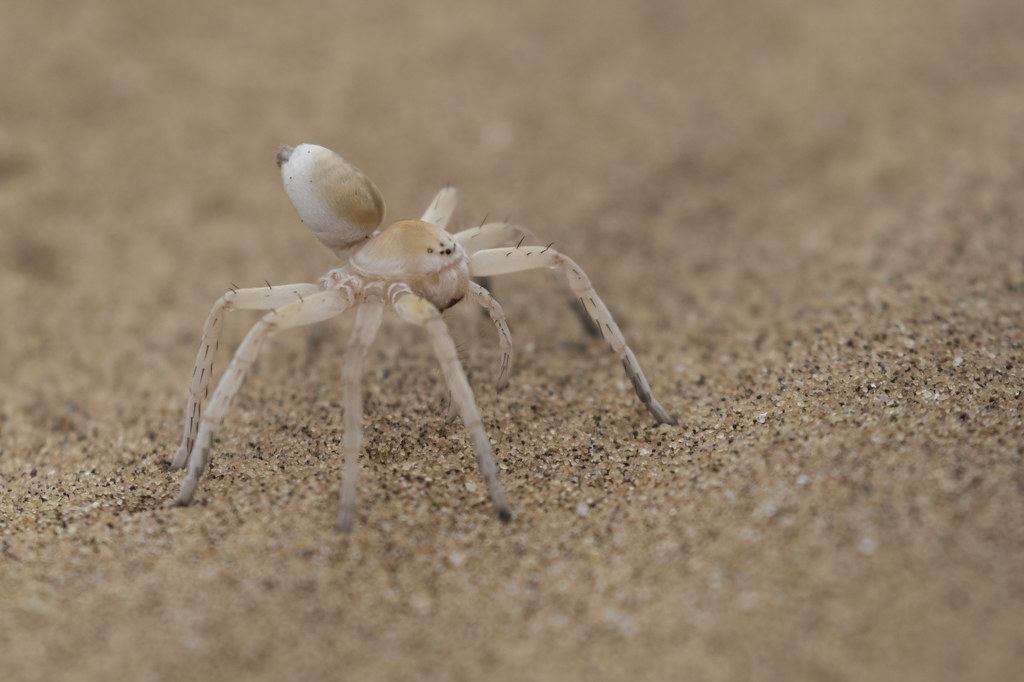
She's one of a male's worst enemies as she eats her partner after mating. Charming.
Once again Nico, our guide, showed amazing compassion and set up a shield to ensure the spider managed to tunnel a new burrow before falling victim to a bigger predator .
Next up the burrowing Skink. You have to be fast to catch them too, they don't half shift. They look just like the Slow Worms we have in our garden at home.
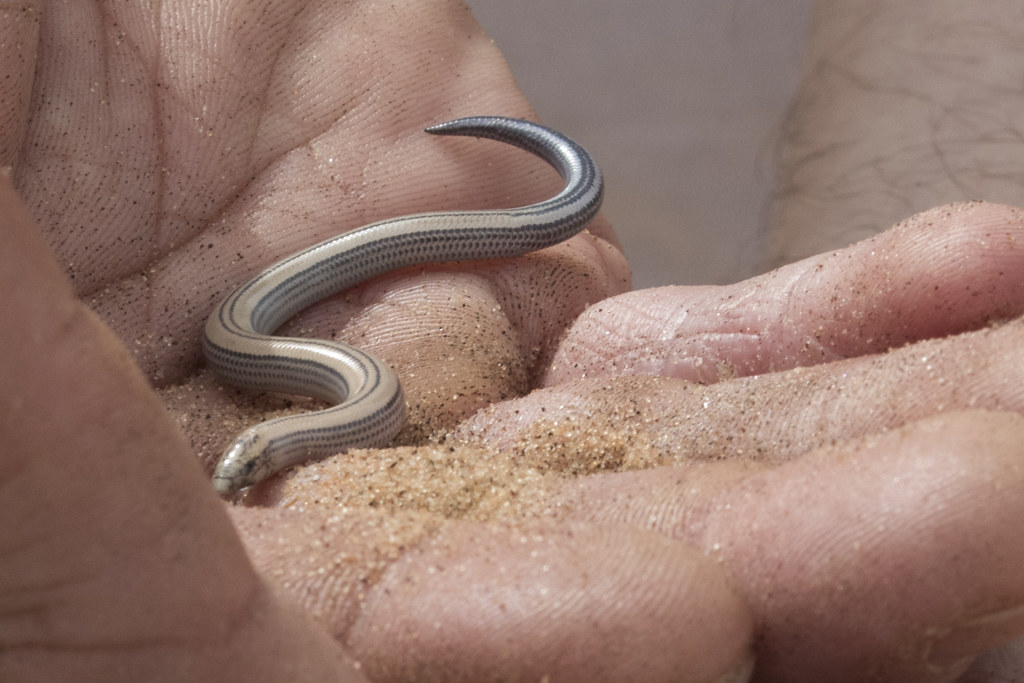
Three down , two to go but this one wasn't included.
The Sand Diving Lizard.

Nico had found a great spot for them. He threw a few meal worms out of the car window and down the dunes they came to gobble them up. Not nearly as impressively as the next one though.
The Desert Chameleon, what a reptile! Not only does it change colour.

to suit the surrounds
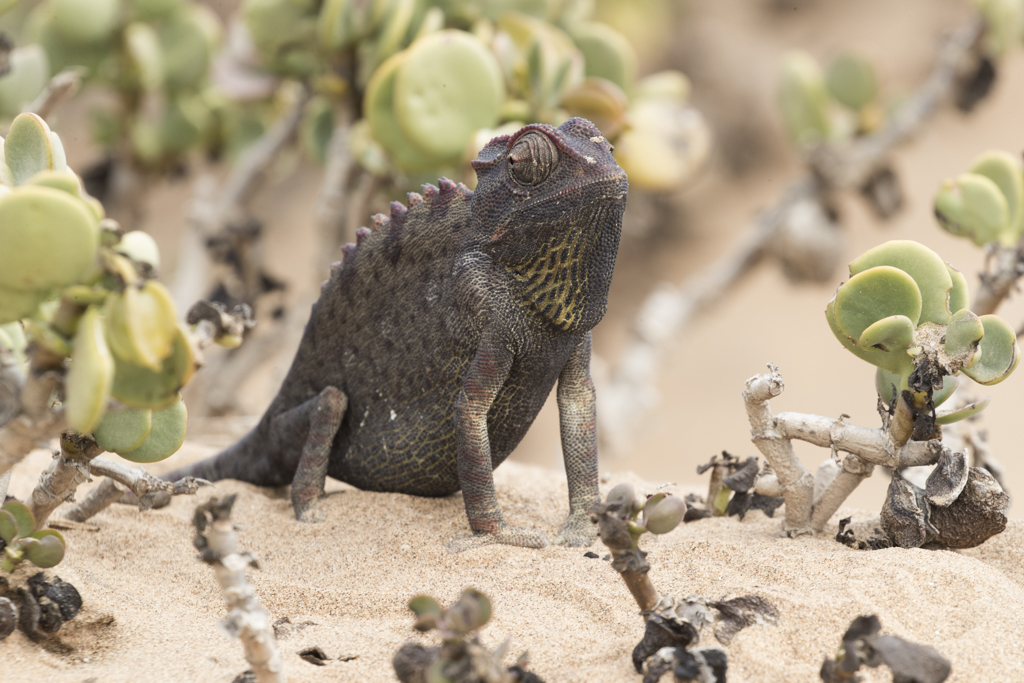
It's a superb photo challenge too!
All that's needed is a camera that shoots 14 frames per second, a meal worm and a bit of luck!
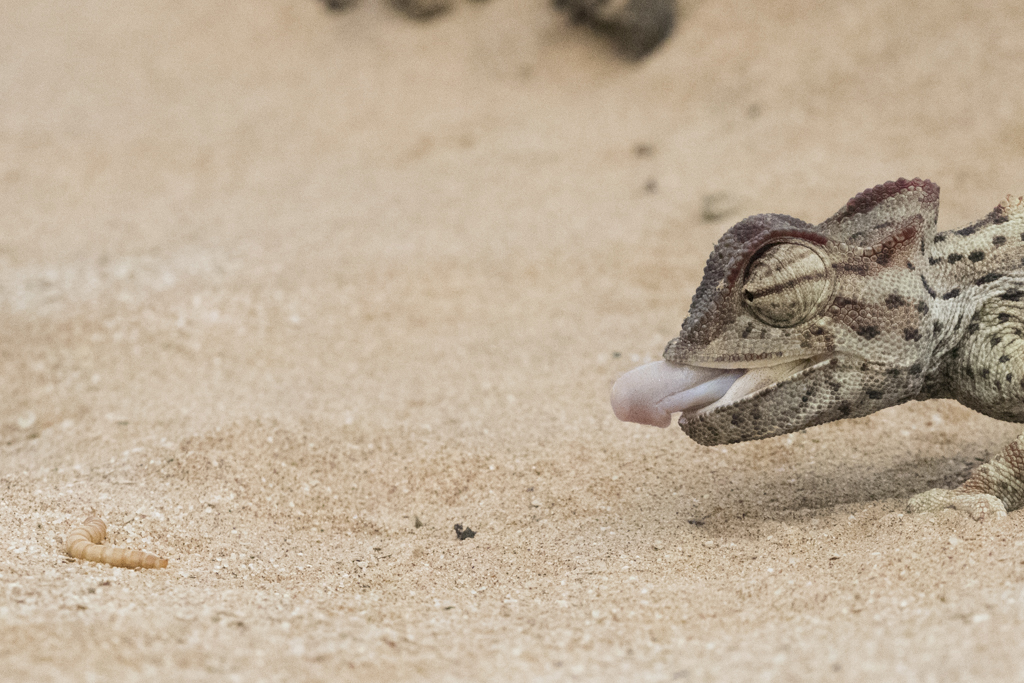
That tongue is something else!
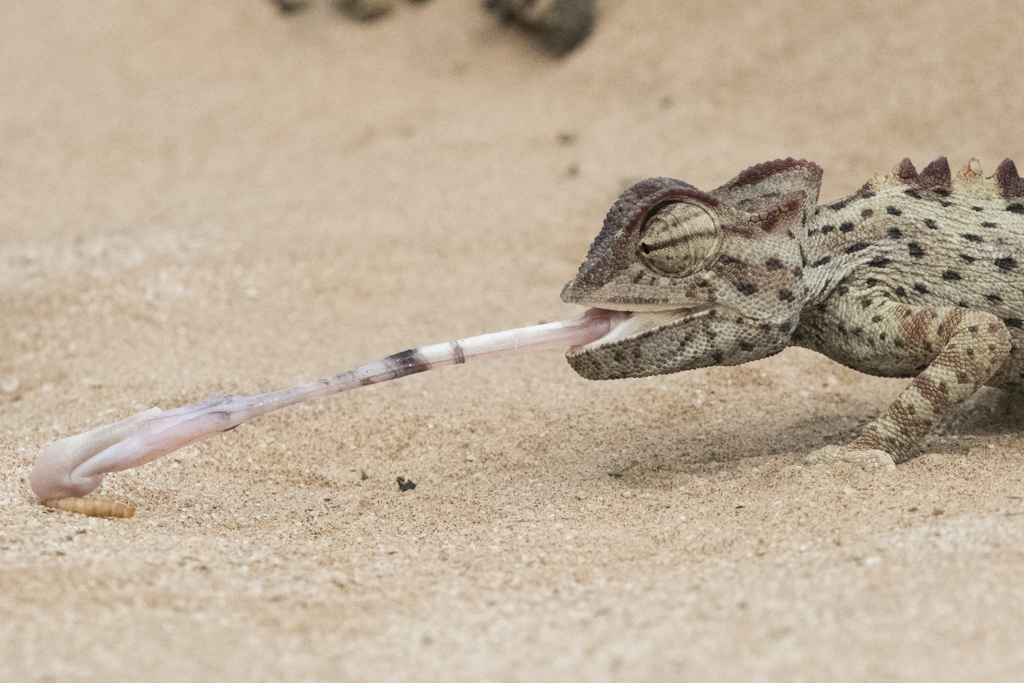
It's all happens in the blink of an eye.
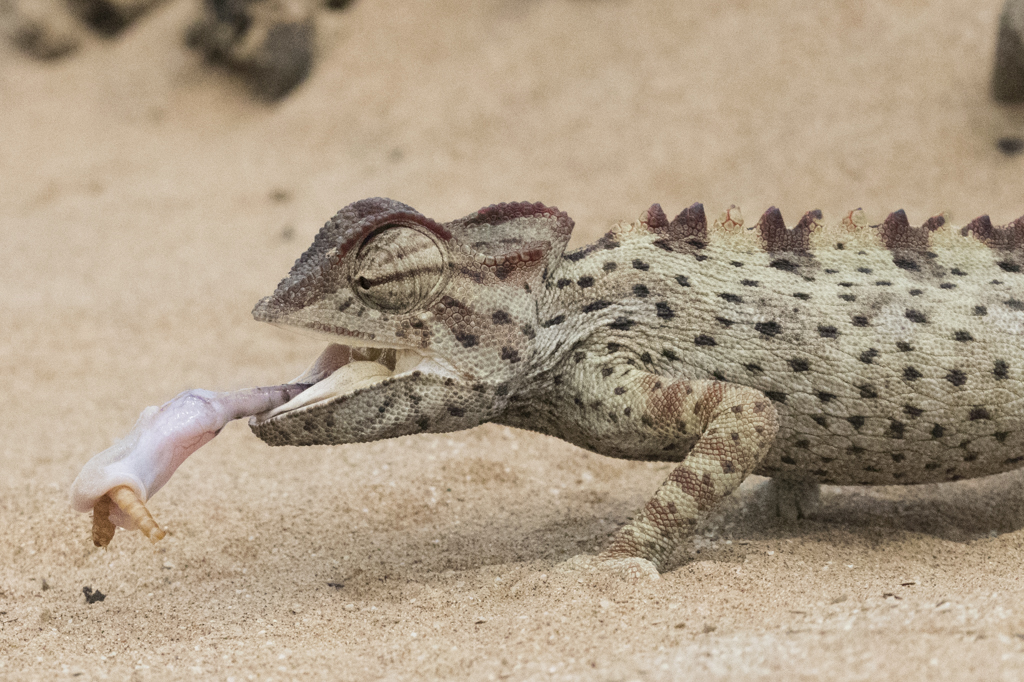
A great challenge too!

Having done the single frames I wanted to try video! Not easy as the viewfinder is the rear screen and with the sun behind you it's difficult to see what you were doing. I'll try posting something separately.
If that was fun the next was slightly scary!

The Peringuey's Adder ( also known as a Sidewinder) hides in the sand with just it's eyes and tip of it's tail showing. It waggles the tail to make it look like a grub and strikes at anything that takes a fancy to maybe eating the said grub!
It's not usually fatal if you get bitten but it's most painful and unpleasant. I kept my distance!
That was the Little 5 completed!
We also came across a new bird for me too, the Tractrac Chat.
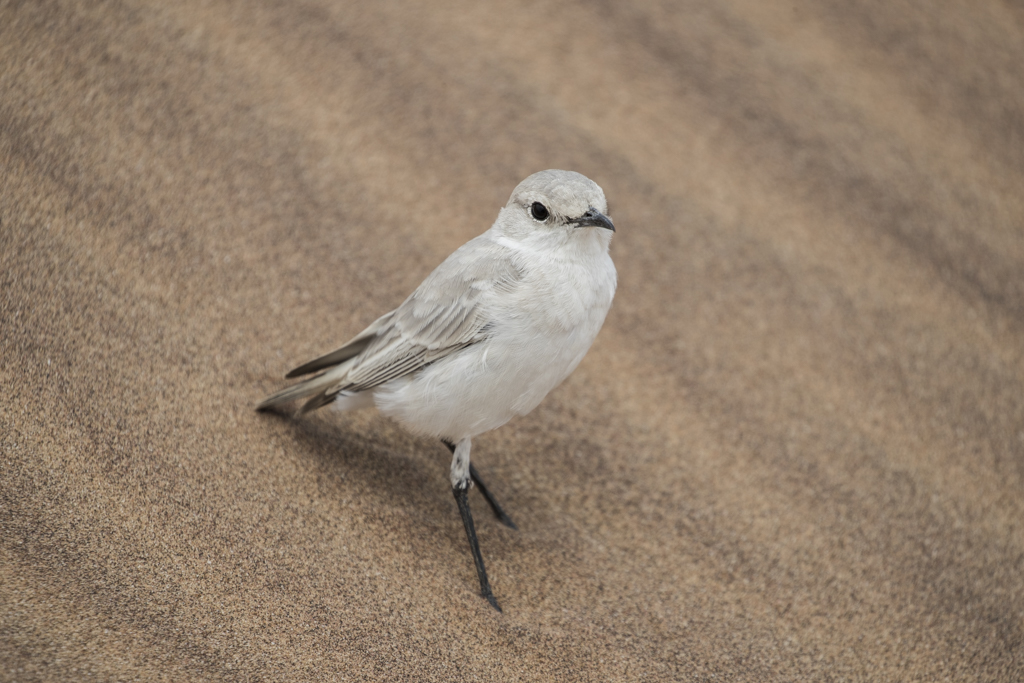
This one too responded to a tossed mealworm, hence the close views!
Our guide was excellent, he told us about the mineral content of the sand and showed us how to extract the iron that gives the sand a dirty appearance in some places and told us about the purple sand which is actually made of tiny Garnet stones. All interesting information.
We also got a dune tour and ride thrown in too!
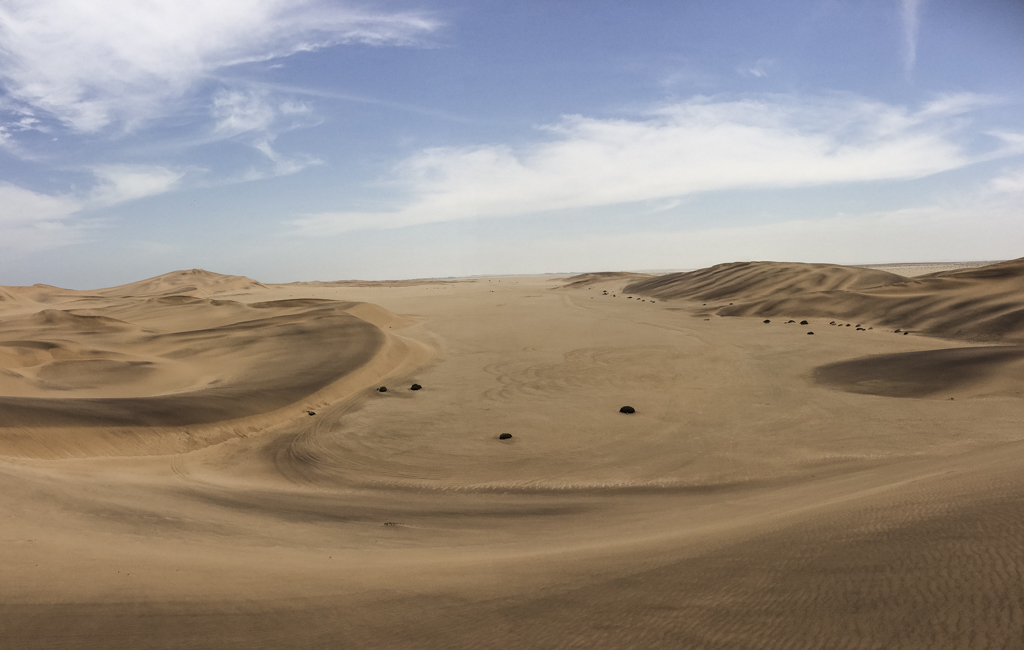
Maybe not the high speed or steep drops we had achieved the previous day but in many ways more rewarding to savour the views rather than see them disappear in an instant at speed.

No for my money, all 700NR or £43pp, this was the highlight not only of Swakopmund but the whole holiday and I think Claire has exactly the same thoughts. The tour only lasts half a day but that's fine, it left us time to pack etc etc but what a great way to end our trip !
Not only that but dinner in The Tug with the best seats in the house, what else could you want?

Fantastic.
Of course this wasn't quite the last day, we had set aside a whole day to travel back to Windhoek and that I'll keep to tell you about later!
T.B.C.
My original choice of tour operator had been fully booked for this our last day and in hindsight we were so lucky. Just four of us and as it turned out an extremely dedicated and excellent guide.
This was the company logo

Taken from the side of their vehicle and those are my sandals!

Loads of space, a guide between four of us, things looked much better than the other tour operators set up who we happened to pass. They were full to overflowing !
Would our guide measure up?
Well it certainly seemed so. He gave us an introductory talk about the deserts, the source of water from the sea mists, the moisture retaining plants and the "muesli" of seeds and plant fibres that blow about self seeding plants and providing food for a variety of creatures that make what seems an inhospitable environment their home.
I'll never look at sand dunes the same way again !
Look closely and you will be amazed at the number of tracks in the sand, each individual to the creature that left them. Our guide used them all to find our target species. He was better than Tonto ( if you are under a certain age you won't appreciate how good he was!)
First off he found us the endemic Palmato Gecko as shown on their logo.

He was careful to make sure it found a new hiding place safe from predation before moving on in search of our next target, the venomous Dancing White Lady Spider

You can see why she is so named when she rears up on her legs as if in a dancing move.

She's one of a male's worst enemies as she eats her partner after mating. Charming.
Once again Nico, our guide, showed amazing compassion and set up a shield to ensure the spider managed to tunnel a new burrow before falling victim to a bigger predator .
Next up the burrowing Skink. You have to be fast to catch them too, they don't half shift. They look just like the Slow Worms we have in our garden at home.

Three down , two to go but this one wasn't included.
The Sand Diving Lizard.

Nico had found a great spot for them. He threw a few meal worms out of the car window and down the dunes they came to gobble them up. Not nearly as impressively as the next one though.
The Desert Chameleon, what a reptile! Not only does it change colour.

to suit the surrounds

It's a superb photo challenge too!
All that's needed is a camera that shoots 14 frames per second, a meal worm and a bit of luck!

That tongue is something else!

It's all happens in the blink of an eye.

A great challenge too!

Having done the single frames I wanted to try video! Not easy as the viewfinder is the rear screen and with the sun behind you it's difficult to see what you were doing. I'll try posting something separately.
If that was fun the next was slightly scary!

The Peringuey's Adder ( also known as a Sidewinder) hides in the sand with just it's eyes and tip of it's tail showing. It waggles the tail to make it look like a grub and strikes at anything that takes a fancy to maybe eating the said grub!
It's not usually fatal if you get bitten but it's most painful and unpleasant. I kept my distance!
That was the Little 5 completed!
We also came across a new bird for me too, the Tractrac Chat.

This one too responded to a tossed mealworm, hence the close views!
Our guide was excellent, he told us about the mineral content of the sand and showed us how to extract the iron that gives the sand a dirty appearance in some places and told us about the purple sand which is actually made of tiny Garnet stones. All interesting information.
We also got a dune tour and ride thrown in too!

Maybe not the high speed or steep drops we had achieved the previous day but in many ways more rewarding to savour the views rather than see them disappear in an instant at speed.

No for my money, all 700NR or £43pp, this was the highlight not only of Swakopmund but the whole holiday and I think Claire has exactly the same thoughts. The tour only lasts half a day but that's fine, it left us time to pack etc etc but what a great way to end our trip !
Not only that but dinner in The Tug with the best seats in the house, what else could you want?

Fantastic.
Of course this wasn't quite the last day, we had set aside a whole day to travel back to Windhoek and that I'll keep to tell you about later!
T.B.C.
Namibia 2017 Part 22. Walvis Bay and Sandwich Harbour
Along with the Rhino trekking at Grootberg, today's trip was the only other we had booked ( or thought we had) before leaving the UK. Highly recommended on Trip Advisor we decided to go with it despite the cost which was 3600NR or around £230 . Perception of cost and value is a very subjective thing. Being of a certain age I remember when I would pay 25p to go and watch Liverpool FC play, in fact I was lucky enough to be taken by my Dad to see the World Cup final of 1966 at Wembley( the only time England have ever won anything significant) and the tickets were priced at 10/- which in today's money is 50p. My tickets for Anfield next season are £45 per match which is 180x the price in the late 60's. We returned to Wembley last year for a Cup final game and paid £90, again 180x the price albeit in both cases they were for seated views as standing places has been banished in the UK since the Hillsborough disaster. It does give me a sense of perspective on what other entertainment offers as value for money. 90 minutes for £45 at Anfield or a full day out for £115.
The tour has to be considered excellent value then!
We were picked up from our accommodation at 7.00am and driven the 30kms to Walvis, picking others up en route.
The boat sailed at 9.00am and the tour lasted until around lunch time and a light lunch of fresh Oysters, various nibbles and beers, fizzy wine or soft drinks was included .
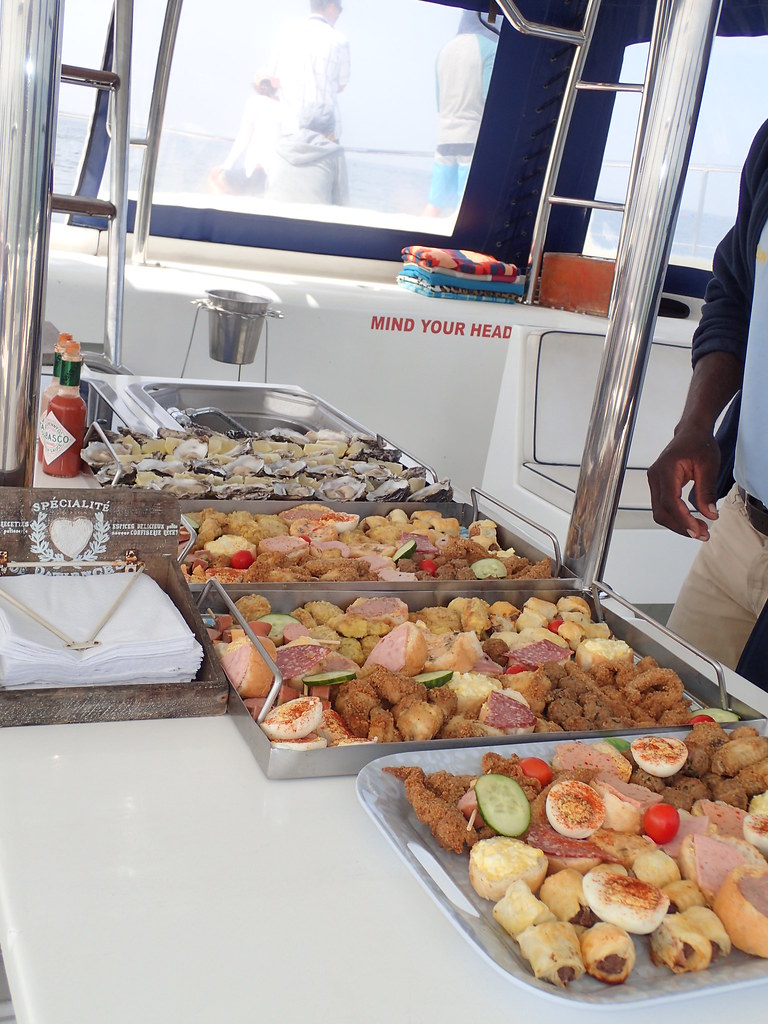
There was plenty to go around too so that was good.
The captain stopped on several occasions to come and give a talk about what we were looking at, telling us about the boats in the harbour, why the oil rigs were there and the typical costs involved.
The first cruise liner to arrive last year was charged $65,000US to dock for 7 hours. Interesting stuff.

All the time we were sailing large flocks of Cape Cormorant were flying around but the party trick was the Great White Pelicans.
Shame they didn't warn you what was going to happen next but on blowing a whistle in they flew.
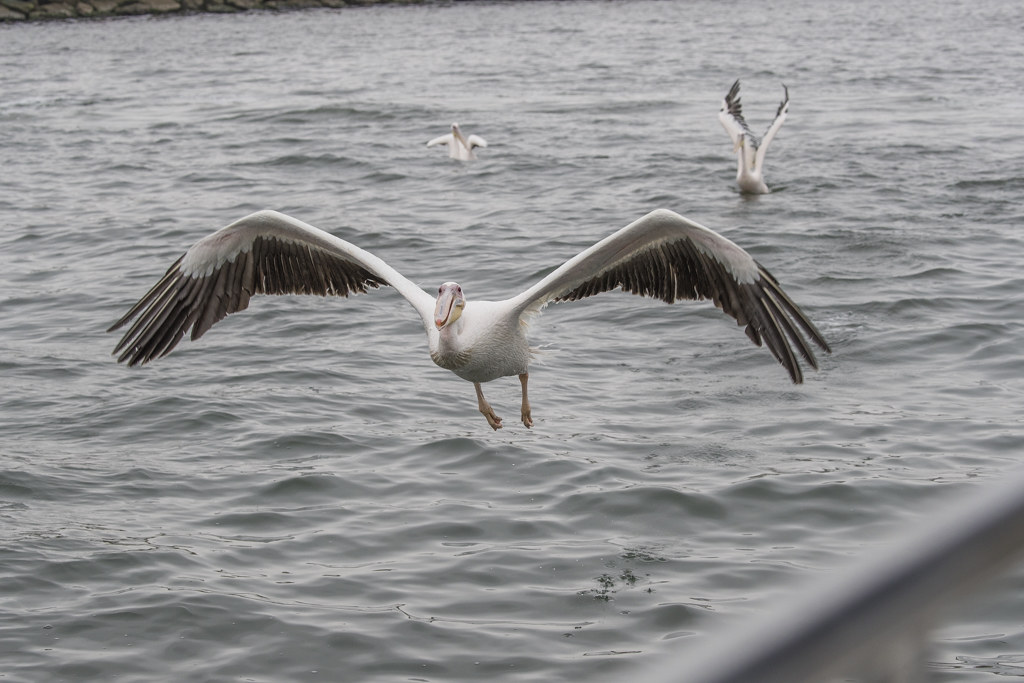 r
r
right alongside
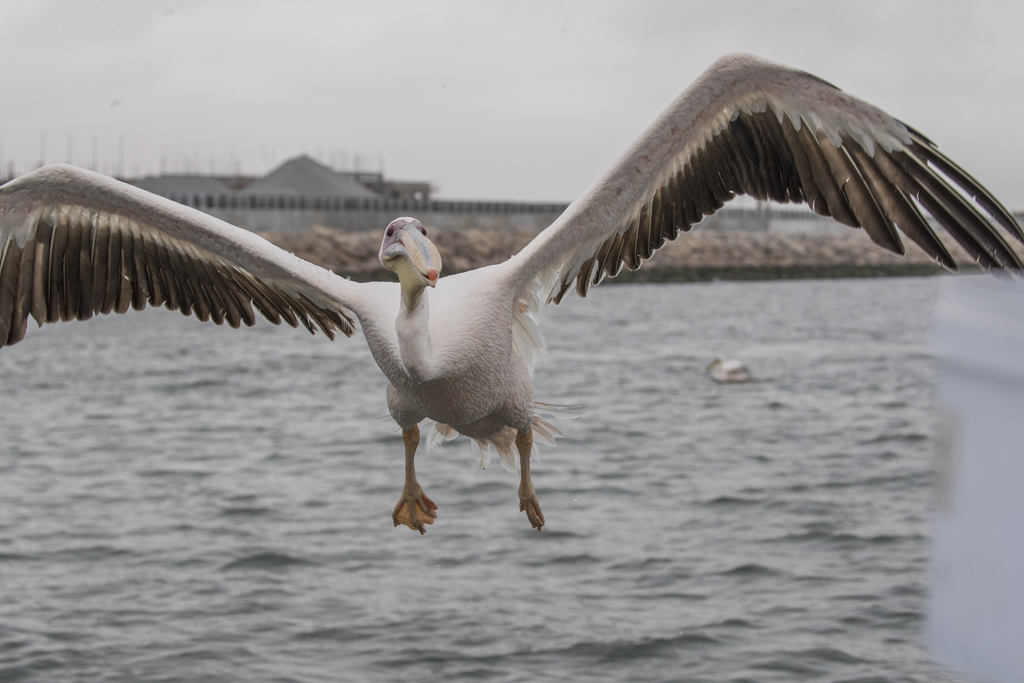
One of the deck hands had a bucket of fish!
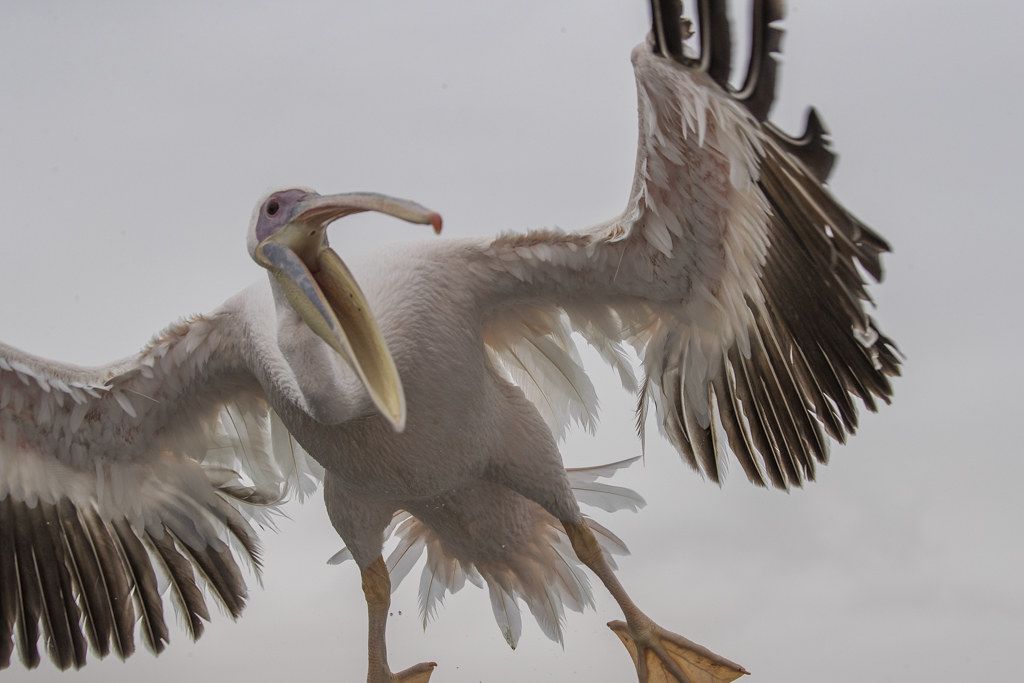
I was at the back of the boat and the deck hand was at the front so I missed the first one totally, the second bird I was in the wrong position as someone leant in front of me (Grrrrrr!) but the third time was a bit better.
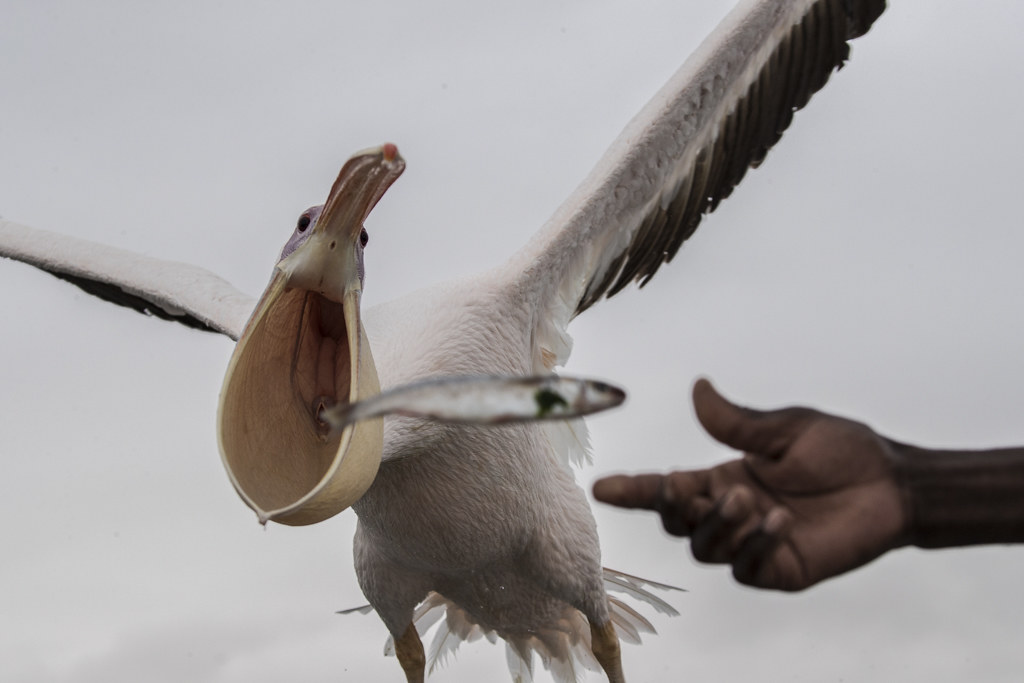
I was amazed to see the size of the pouch!
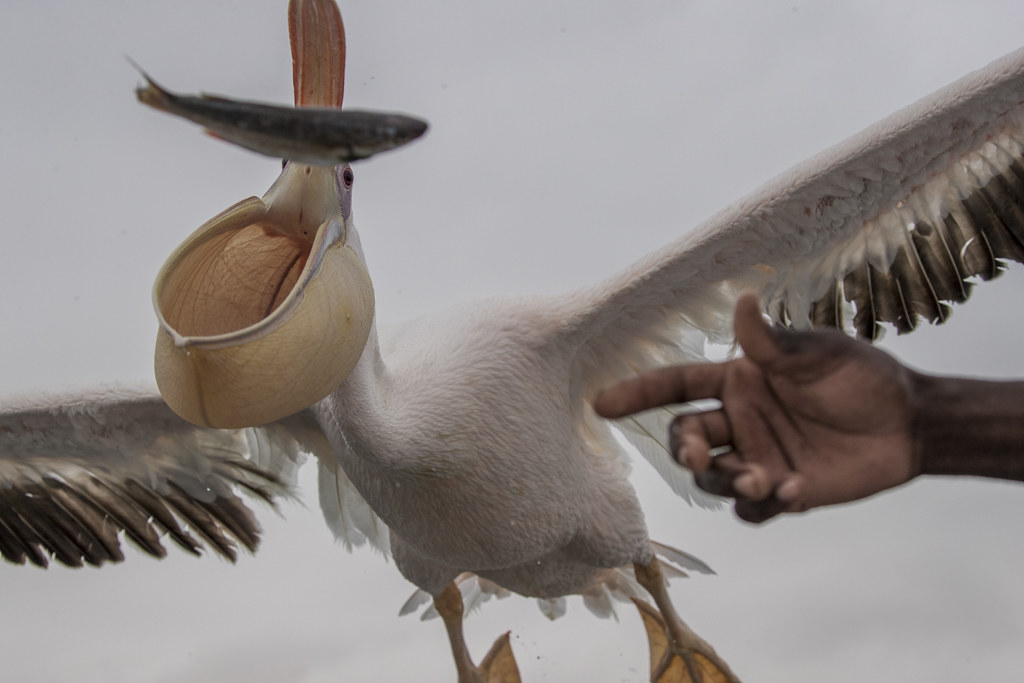
I only wished I had a smaller lens as the short end of the 100-400mm was still far to long.
To get that right I would need a lot of practice but the birds weren't interested in another offering, well not in flight anyway.

They landed on the boat preferring to take the fish standing up.
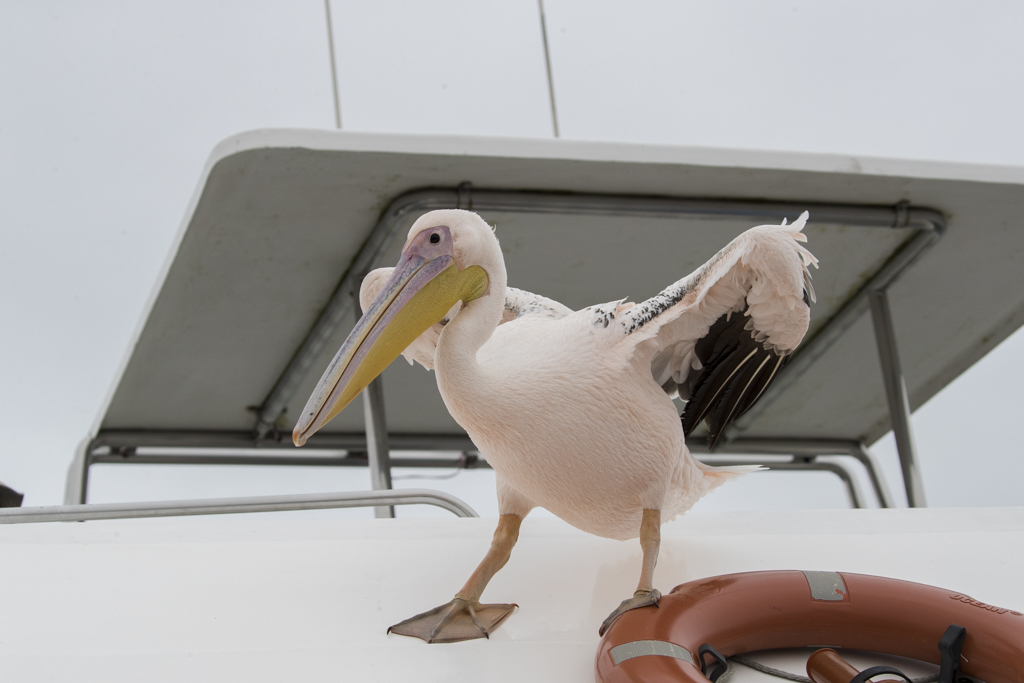
I'm not sure that this was my idea of wild life watching but the photography was an interesting challenge. Should you go though, be prepared. Something like a 50mm lens would be much better I would think.
Next stop was out at Pelican Point and the Seal colony ( the alternative to Cape Cross)

There are trips that allow you to kayak amongst them if that's your fancy. On our boat they had another trick. Once more the bucket of fish and whistle appeared and up popped a seal.
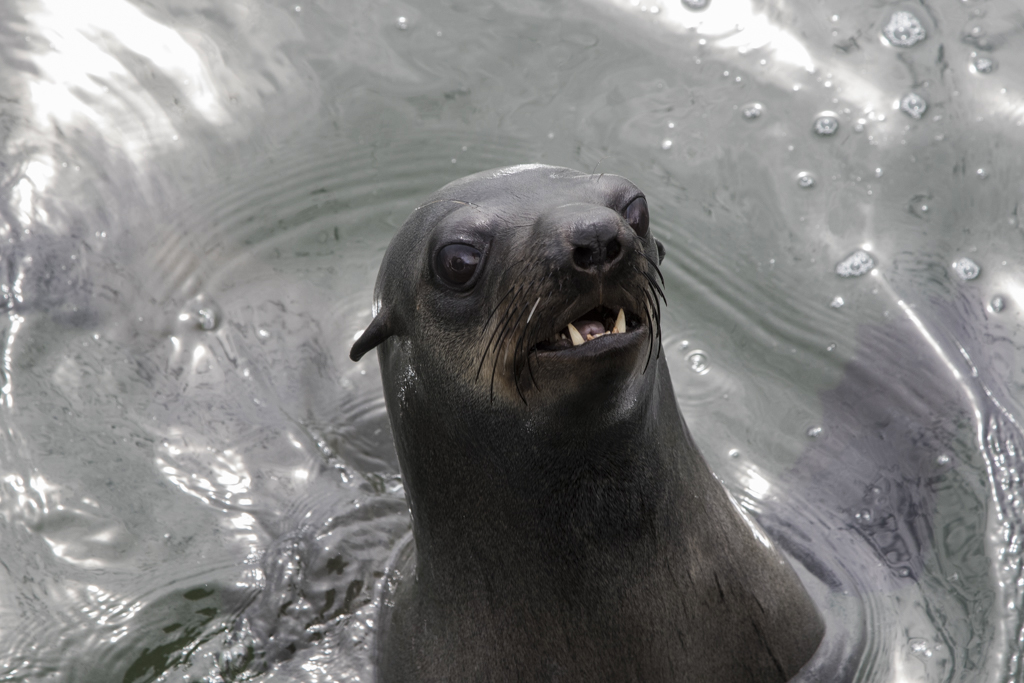
This one was a young one being trained still and everyone was told not to touch it in case it bit them. You can see they have a decent set of teeth too!
Amazing the way they could actually climb on to the boat, they must have amazing strength, but of course they are used to climbing slippery rocks too.
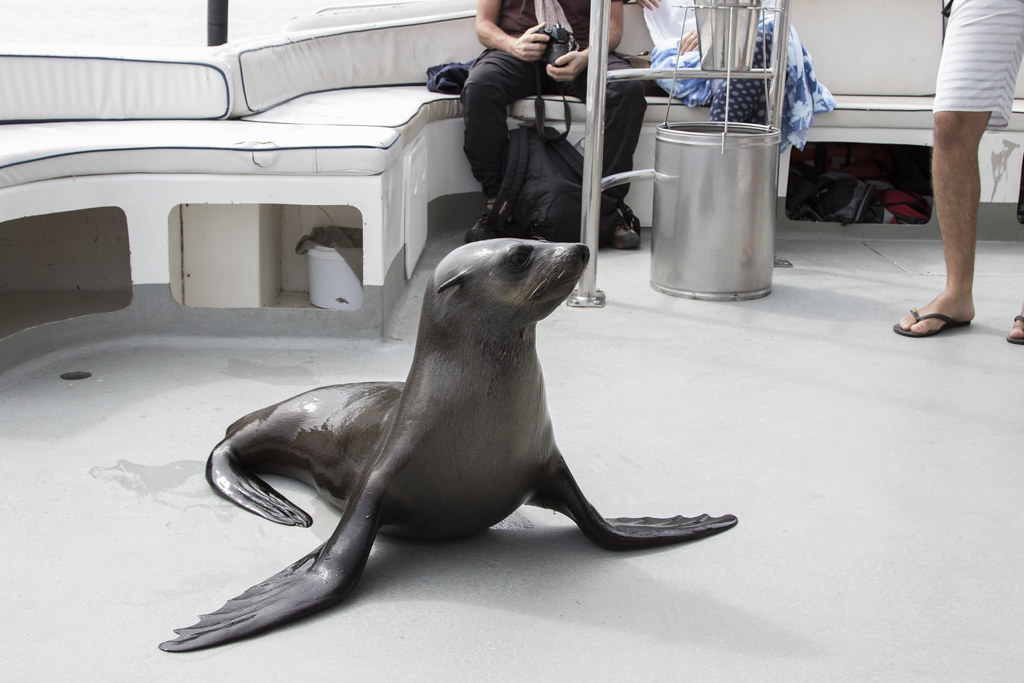
If I'm honest I didn't enjoy the seal experience mainly because others on the boat wanted to pose for selfies with them and in one case an aged Italian woman kept on going over to the seal and doing her seal talk imitations. Earlier I had helped her climb down some steps from the bow of the boat, now I could have happily pushed her overboard! These are wild animals but somehow, well I'm sure you understand so I won't go any further.
Apparently Namibia's fish quota is 550,000 tonnes of fish a year. They estimate the ever growing population of Cape Fur Seals, a protected species, consume 15,000,000 tonnes a year. Food for thought indeed.
The one thing Walvis Bay is famous for are Oysters. They are imported as tiny oysters from South America (it's too cold to breed in Namibia but the waters are full of food for them to eat) hung on ropes secured to oil drums and left to mature out in the bay. I got lucky and saw an Artic Skua fly past whilst the captain was telling us all about them!
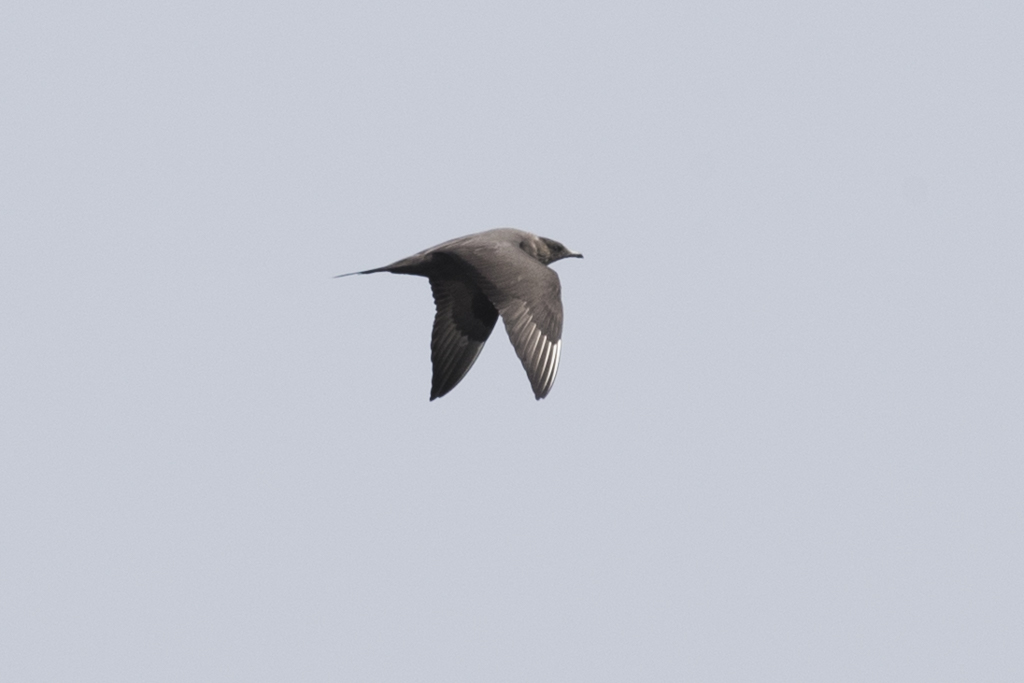
That was about it for the boat trip, very informative on many aspects and certainly enjoyable but from a wild life perspective not really my cup of tea.
We disembarked the boat and set off for the afternoon Dune tour. This time only four of us from the original boat full of perhaps 16-20.
We drove for 55 kms to Sandwich Harbour and as the tide was out we were able to go the whole way along the beach. We passed several convoys of campers who apparently pay large sums running in to tens of thousands to do these escorted tours from Luderitz or possibly further south. 55kms was enough for me, the view never changed really although when you get towards Sandwich Harbour the really big dunes meet the sea.
We stopped on the beach for more snacks and drinks overlooking the lagoon.
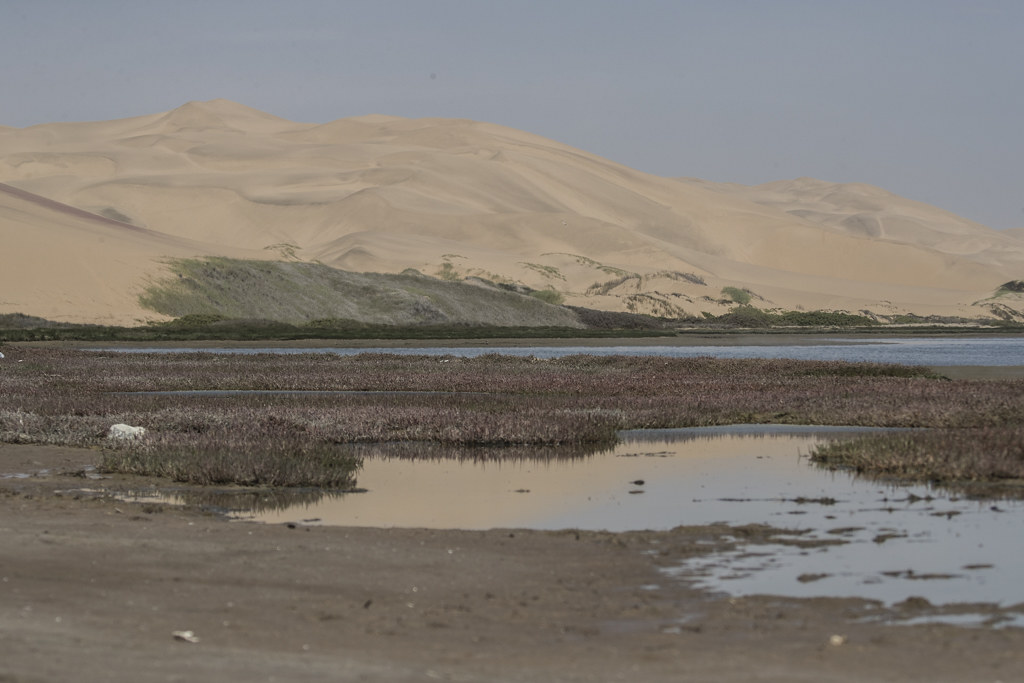
It's supposedly a very important breeding area for birds but other than a few dozen Pelicans in the far distance and a nearby pair of White-fronted Plover there was little evidence of avian life whatsoever.
Had the tide been in we would have viewed all this from the top of the dunes we were told, there were 4 vehicles of various tours there and some enthusiastic folk claimed to the top, maybe 100m or more above sea level. I drank their beer allocation and watched! We were driven up there next so it was an effort I didn't need to make.
In fairness the views were spectacular.
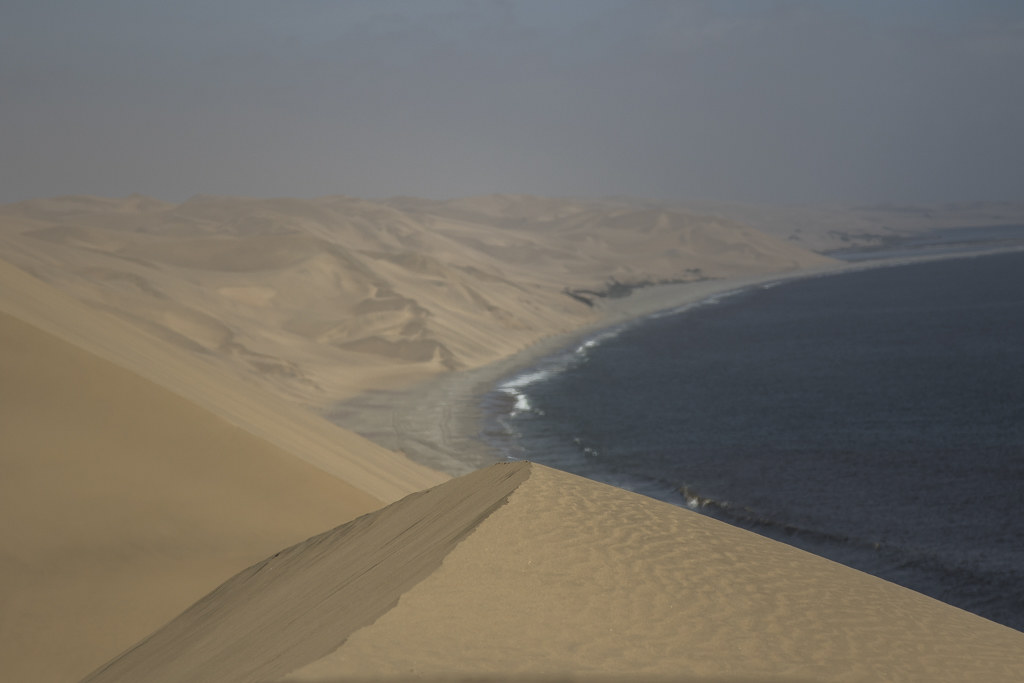
Unlike anything I have ever seen before.

Next we were off for an exhilarating dune ride. It takes a lot of skill and practice to get it right and for the uninitiated it's quite a thrill. Going down the big dunes at slow speed you were staggered the vehicle didn't just drop as they were so steep then at the bottom it was foot flat down to climb up the next one at speed. Good fun for a while but it was a bit repetitive, especially the bit where we drove back along the beach.
All we saw was sand for the most part....hardly unexpected.....but the desert wildlife was nowhere to be seen other than a pair of Ostrich.
And by special request by me, I asked if there was a place to see Dune Lark.
Our driver duly obliged!

Well it was a bit distant and had I been alone I would have waited for a closer view but I wasn't so I couldn't.
The best I can do is crop the image.
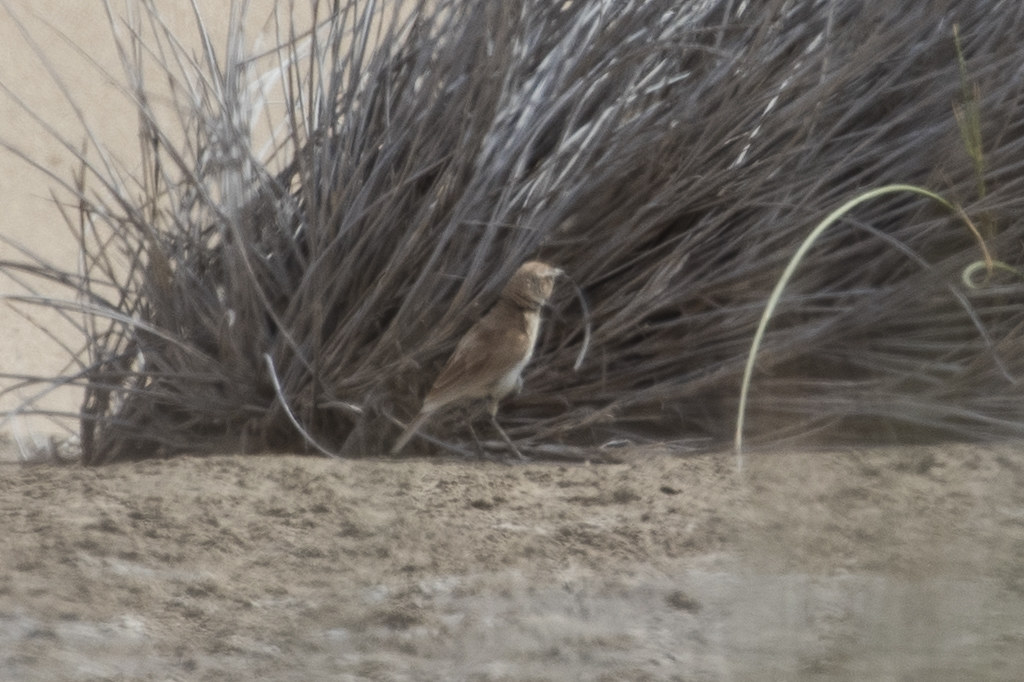
Is it or isn't it? Well he said it was anyway!
We were driven all the way back to Swakopmund so a total of around 150kms during the afternoon. It was 6.00pm so a total tour time of 11 hours. A long day.
Enjoyable?
Yes, it was different and we were not planning to go to Sesriem to climb the dunes there either so it was a nice taster tour of sand even if I am not a fan of climbing it.
That evening we had booked The Wreck restaurant telling them we might be a bit later than the 7.30 pm we were booked in for. Sure enough we had a reserved table in the window but to our horror the place was packed with large tour groups that night. We were knackered and didn't fancy waiting an age for our dinner. We skipped starters and ordered a main to try and save some waiting and to our delight we were served before any of the big tables around us.
Nice one! We'd have gone again but the following day was already booked at The Tug for our last night and the lovely lady on the desk had promised us a window seat for our penultimate mealiness Namibia.
Our last day was to be spent tmaking the Living Desert Tour in search of the Little 5.
Open verdict on that as we we hadn't too much idea what to expect.
T.B.C.
The tour has to be considered excellent value then!
We were picked up from our accommodation at 7.00am and driven the 30kms to Walvis, picking others up en route.
The boat sailed at 9.00am and the tour lasted until around lunch time and a light lunch of fresh Oysters, various nibbles and beers, fizzy wine or soft drinks was included .

There was plenty to go around too so that was good.
The captain stopped on several occasions to come and give a talk about what we were looking at, telling us about the boats in the harbour, why the oil rigs were there and the typical costs involved.
The first cruise liner to arrive last year was charged $65,000US to dock for 7 hours. Interesting stuff.

All the time we were sailing large flocks of Cape Cormorant were flying around but the party trick was the Great White Pelicans.
Shame they didn't warn you what was going to happen next but on blowing a whistle in they flew.
 r
rright alongside

One of the deck hands had a bucket of fish!

I was at the back of the boat and the deck hand was at the front so I missed the first one totally, the second bird I was in the wrong position as someone leant in front of me (Grrrrrr!) but the third time was a bit better.

I was amazed to see the size of the pouch!

I only wished I had a smaller lens as the short end of the 100-400mm was still far to long.
To get that right I would need a lot of practice but the birds weren't interested in another offering, well not in flight anyway.

They landed on the boat preferring to take the fish standing up.

I'm not sure that this was my idea of wild life watching but the photography was an interesting challenge. Should you go though, be prepared. Something like a 50mm lens would be much better I would think.
Next stop was out at Pelican Point and the Seal colony ( the alternative to Cape Cross)

There are trips that allow you to kayak amongst them if that's your fancy. On our boat they had another trick. Once more the bucket of fish and whistle appeared and up popped a seal.

This one was a young one being trained still and everyone was told not to touch it in case it bit them. You can see they have a decent set of teeth too!
Amazing the way they could actually climb on to the boat, they must have amazing strength, but of course they are used to climbing slippery rocks too.

If I'm honest I didn't enjoy the seal experience mainly because others on the boat wanted to pose for selfies with them and in one case an aged Italian woman kept on going over to the seal and doing her seal talk imitations. Earlier I had helped her climb down some steps from the bow of the boat, now I could have happily pushed her overboard! These are wild animals but somehow, well I'm sure you understand so I won't go any further.
Apparently Namibia's fish quota is 550,000 tonnes of fish a year. They estimate the ever growing population of Cape Fur Seals, a protected species, consume 15,000,000 tonnes a year. Food for thought indeed.
The one thing Walvis Bay is famous for are Oysters. They are imported as tiny oysters from South America (it's too cold to breed in Namibia but the waters are full of food for them to eat) hung on ropes secured to oil drums and left to mature out in the bay. I got lucky and saw an Artic Skua fly past whilst the captain was telling us all about them!

That was about it for the boat trip, very informative on many aspects and certainly enjoyable but from a wild life perspective not really my cup of tea.
We disembarked the boat and set off for the afternoon Dune tour. This time only four of us from the original boat full of perhaps 16-20.
We drove for 55 kms to Sandwich Harbour and as the tide was out we were able to go the whole way along the beach. We passed several convoys of campers who apparently pay large sums running in to tens of thousands to do these escorted tours from Luderitz or possibly further south. 55kms was enough for me, the view never changed really although when you get towards Sandwich Harbour the really big dunes meet the sea.
We stopped on the beach for more snacks and drinks overlooking the lagoon.

It's supposedly a very important breeding area for birds but other than a few dozen Pelicans in the far distance and a nearby pair of White-fronted Plover there was little evidence of avian life whatsoever.
Had the tide been in we would have viewed all this from the top of the dunes we were told, there were 4 vehicles of various tours there and some enthusiastic folk claimed to the top, maybe 100m or more above sea level. I drank their beer allocation and watched! We were driven up there next so it was an effort I didn't need to make.
In fairness the views were spectacular.

Unlike anything I have ever seen before.

Next we were off for an exhilarating dune ride. It takes a lot of skill and practice to get it right and for the uninitiated it's quite a thrill. Going down the big dunes at slow speed you were staggered the vehicle didn't just drop as they were so steep then at the bottom it was foot flat down to climb up the next one at speed. Good fun for a while but it was a bit repetitive, especially the bit where we drove back along the beach.
All we saw was sand for the most part....hardly unexpected.....but the desert wildlife was nowhere to be seen other than a pair of Ostrich.
And by special request by me, I asked if there was a place to see Dune Lark.
Our driver duly obliged!

Well it was a bit distant and had I been alone I would have waited for a closer view but I wasn't so I couldn't.
The best I can do is crop the image.

Is it or isn't it? Well he said it was anyway!
We were driven all the way back to Swakopmund so a total of around 150kms during the afternoon. It was 6.00pm so a total tour time of 11 hours. A long day.
Enjoyable?
Yes, it was different and we were not planning to go to Sesriem to climb the dunes there either so it was a nice taster tour of sand even if I am not a fan of climbing it.
That evening we had booked The Wreck restaurant telling them we might be a bit later than the 7.30 pm we were booked in for. Sure enough we had a reserved table in the window but to our horror the place was packed with large tour groups that night. We were knackered and didn't fancy waiting an age for our dinner. We skipped starters and ordered a main to try and save some waiting and to our delight we were served before any of the big tables around us.
Nice one! We'd have gone again but the following day was already booked at The Tug for our last night and the lovely lady on the desk had promised us a window seat for our penultimate mealiness Namibia.
Our last day was to be spent tmaking the Living Desert Tour in search of the Little 5.
Open verdict on that as we we hadn't too much idea what to expect.
T.B.C.
Namibia 2017 Part 21. Swakopmund and surrounds.
We left Erongo in brilliant sunshine and once again enjoyed the stunning scenic drive of the D2315.
This time though we stopped just the once when I spotted a Black-chested Snake Eagle by the roadside.
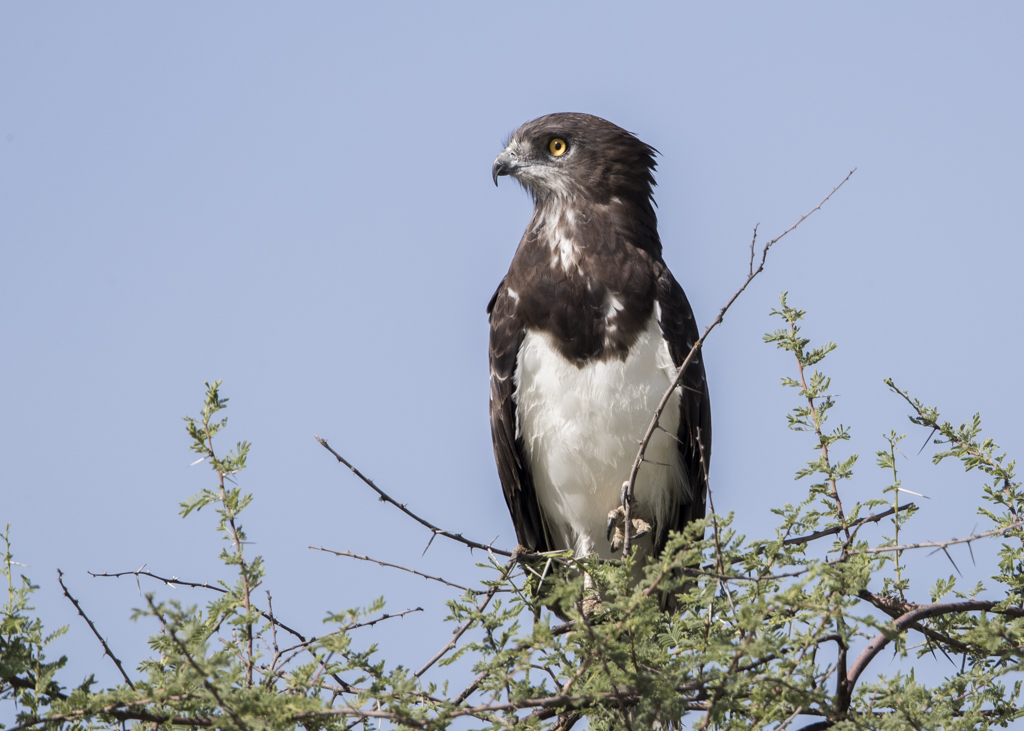
We eventually picked up the tar road of the B2 and arrived at our accommodation in Swakopmund early afternoon.
And the sun was still shining!
We might not have had a pool but the accommodation choice was excellent. We had chosen a self catering apartment at Villa Sohrada in the suburbs of Swakopmund. The hosts live in one house and rent out the apartments in the one next door. We actually stayed in what appeared to be a garage conversion and very comfortable it was too.
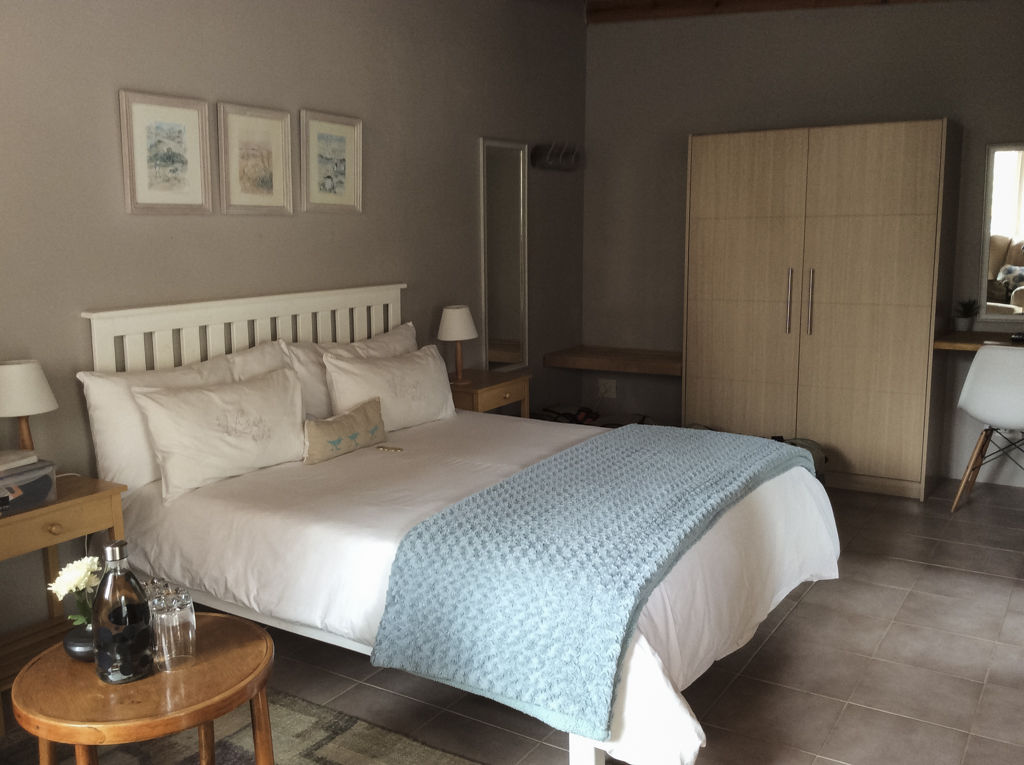
We were greeted with a fruit bowl, tea, coffee, biscuits etc which was all unexpected. Had we wanted to we could have cooked evening meals there too as the kitchen area was equipped with enough to do so but we were only interested in trying the local restaurants.
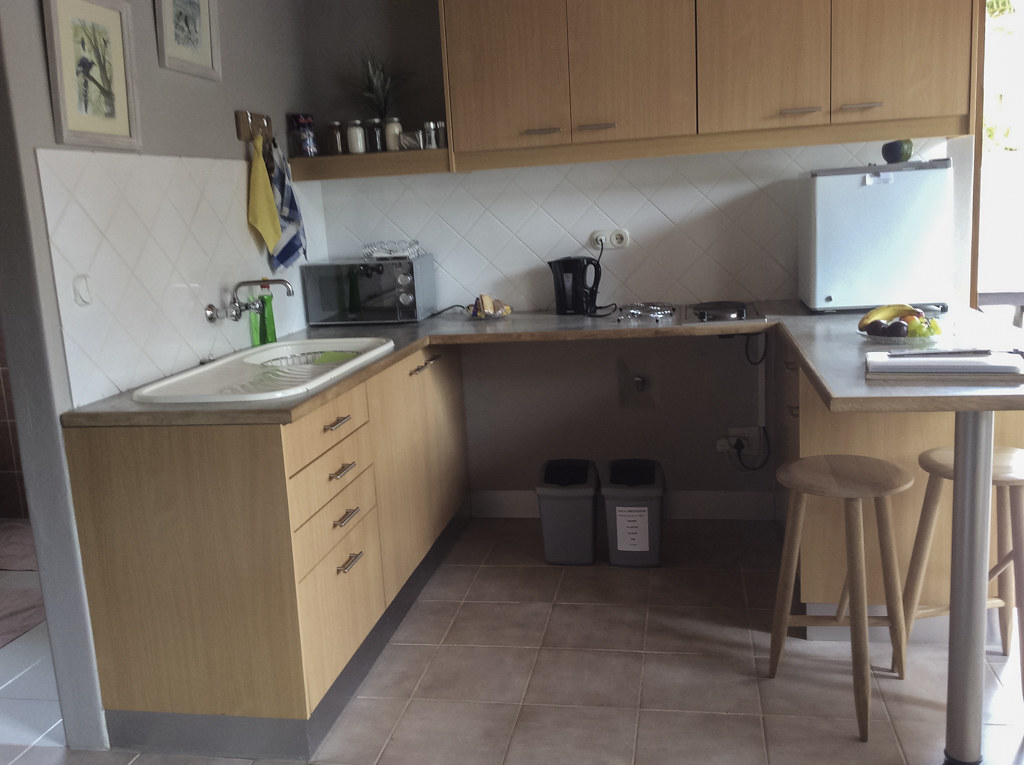
One big benefit was there was an excellent internet connection too, that made a change!

All this for just £40 or 675NR.
That meant that even including dining out it was the least expensive place we stayed.
A drive in to town and the tourist information centre followed and we picked up leaflets on suggested activities in and around Swakopmund. There is certainly plenty of choice! We had already asked our accomodation hosts to book the recommended boat/dune tour trip and that was one day accounted for, we just had to fill the rest. Back at Villa Sohrada I rang a few options. We decided the 2 hour flight in a small plane was too expensive for us at £500, and besides, Claire hates flying so I think she was relieved to find out how much it cost. I tried to book in for a Living Desert tour but they were all fully booked for the next couple of days but I did manage to get a booking for the last day in Swakop, although not my first choice provider. Tomorrow then, it looked like Cape Cross and the Fur seal colony was the best option.
Tonight though we were booked in to The Tug , a well recommended restaurant in the centre of town, a 10 minute drive away.
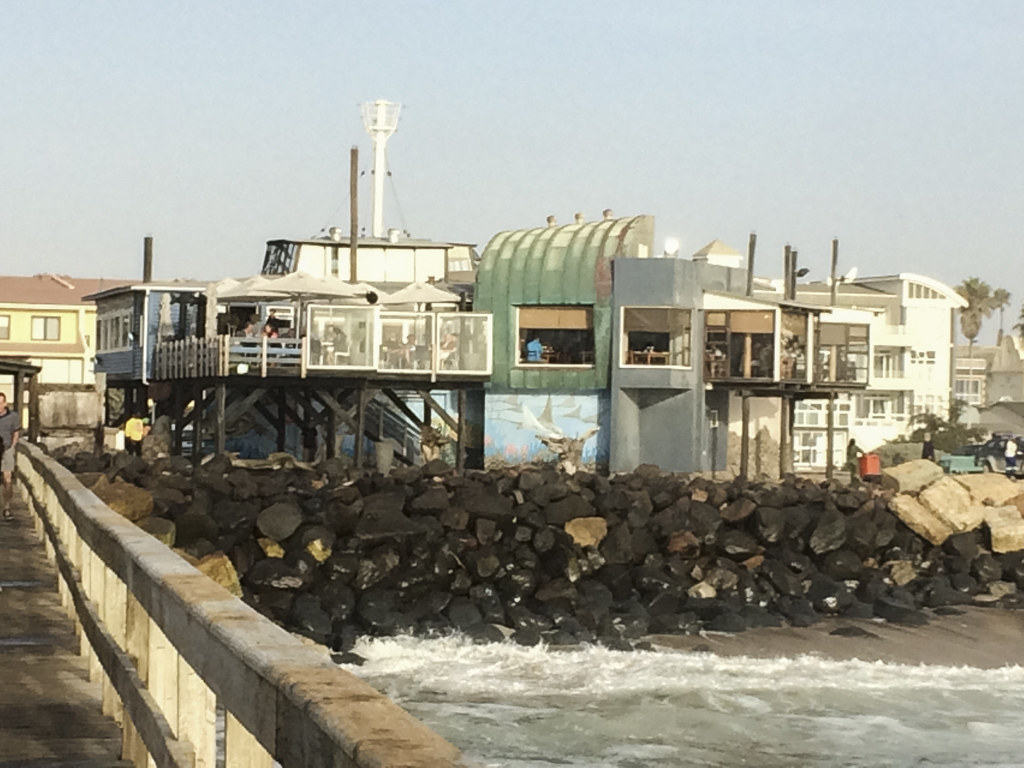
The slightly odd looking building is built around part of a Tug boat, we were lucky to get a table with a sea view and you can watch the sun go down over the horizon and see hundreds of Cormorants and Flamingo's heading to their roosting spots.
The food is inexpensive by UK standards and very palatable too. I would have preferred mushy peas to salad with my fish and chips though!
Once again. our second day in Swakopmund had the sun shining through and off we headed north to Cape Cross.
It's a longer drive than you think and driving through the arid desert scenery does get a bit boring after a while.

The light was a strange mix too and as you can see in the photo, heat haze made photography difficult again.
There were the odd distractions though, a wrecked boat is probably on everyone's stopping place.
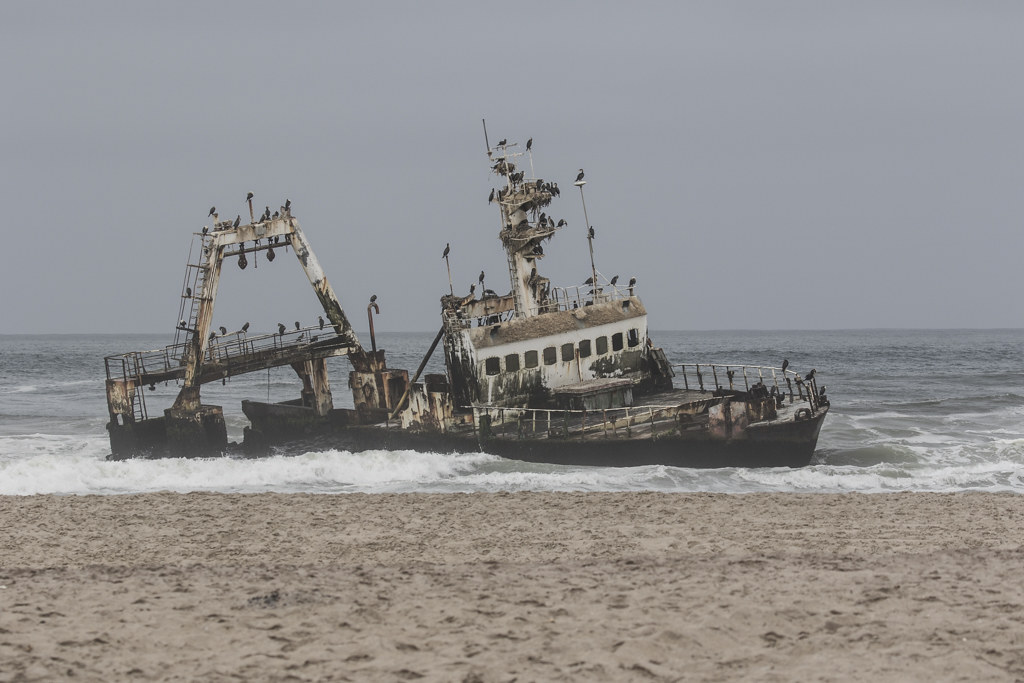
The Skeleton Coast gets it's name from the number of shipwrecks and perhaps there is evidence of more further north but this was the only one we saw.
Arriving at Cape Cross you pay the same entry fee as Etosha. 80NRpp plus 10NR for the car.
We had already read about the smell from the seals and in fairness it wasn't that bad however, once you have seen one seal
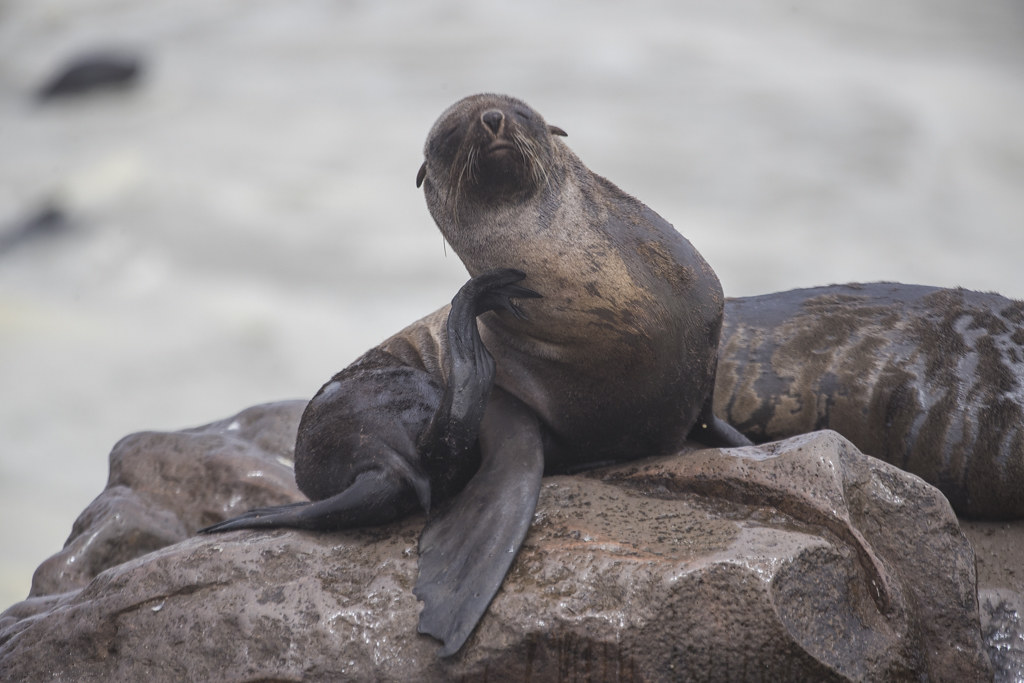
I don't really need to see this many!
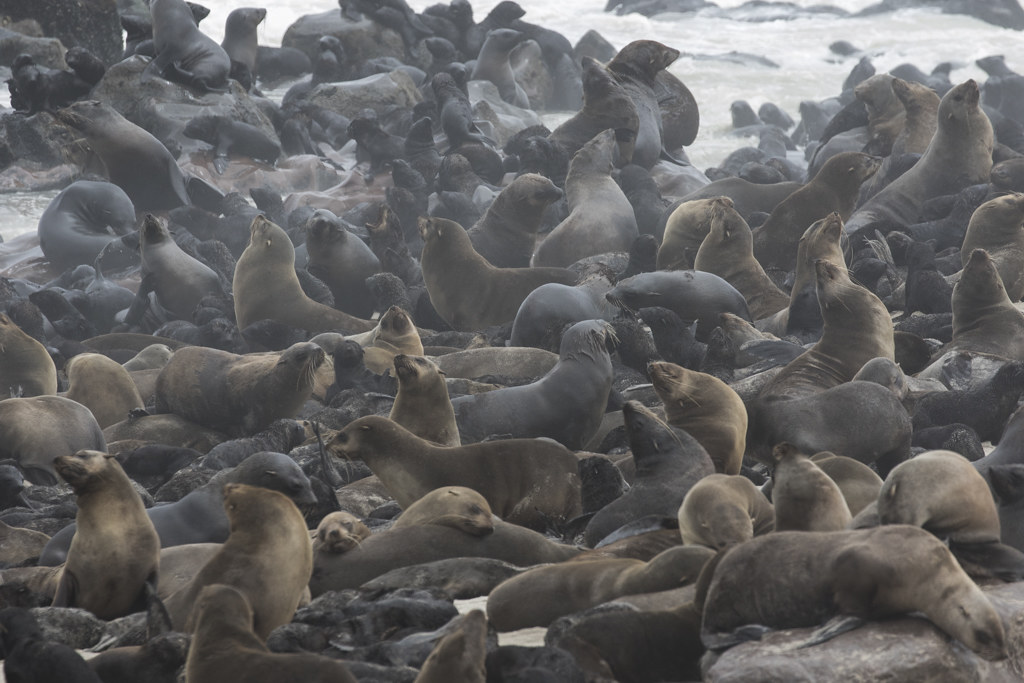
In fairness, quite a sight though.
There are lots of young ones but the mortality rate is around 20%,
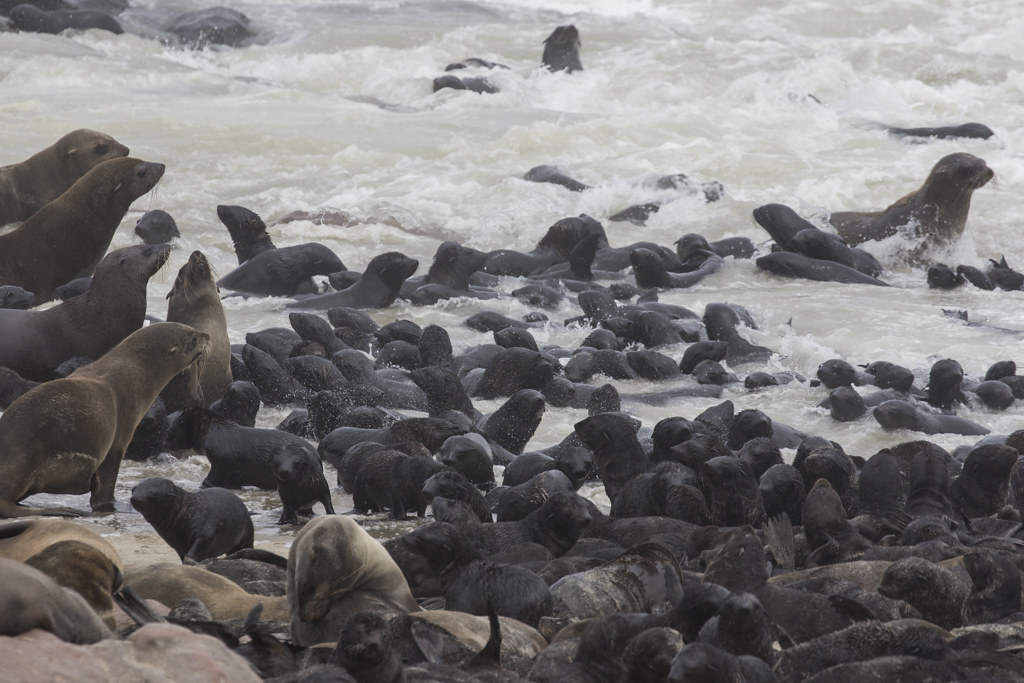
and the smell comes from the rotting carcasses.
Opportunistic Kelp Gulls hang around for an easy meal and the easy entry point is the trough the eye sockets. All a bit gruesome.
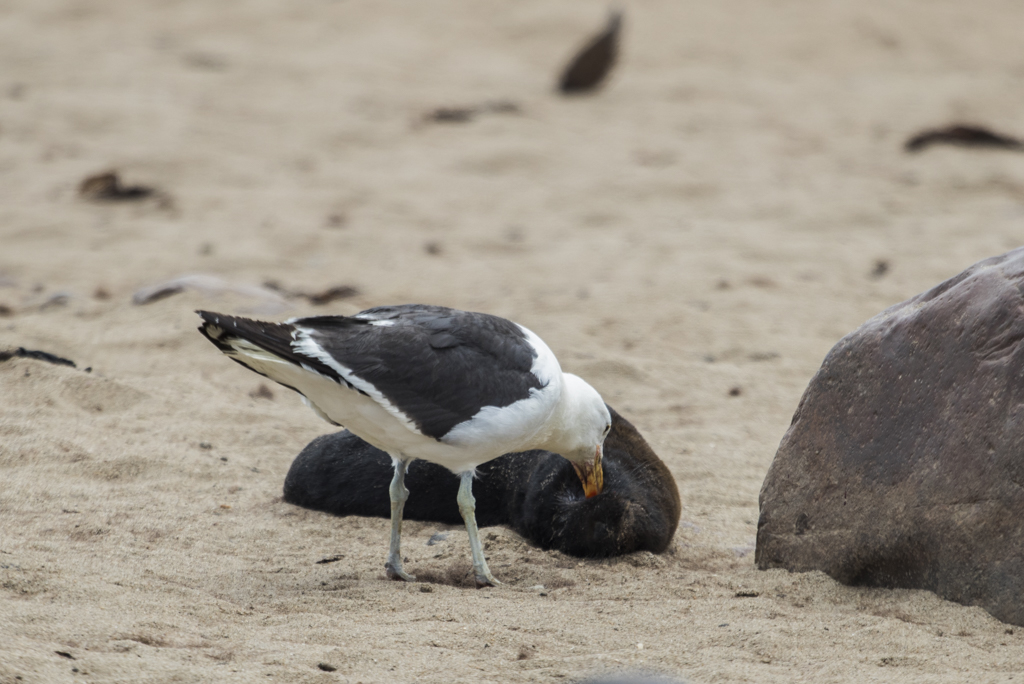
I decided to leave the seal to their slumber
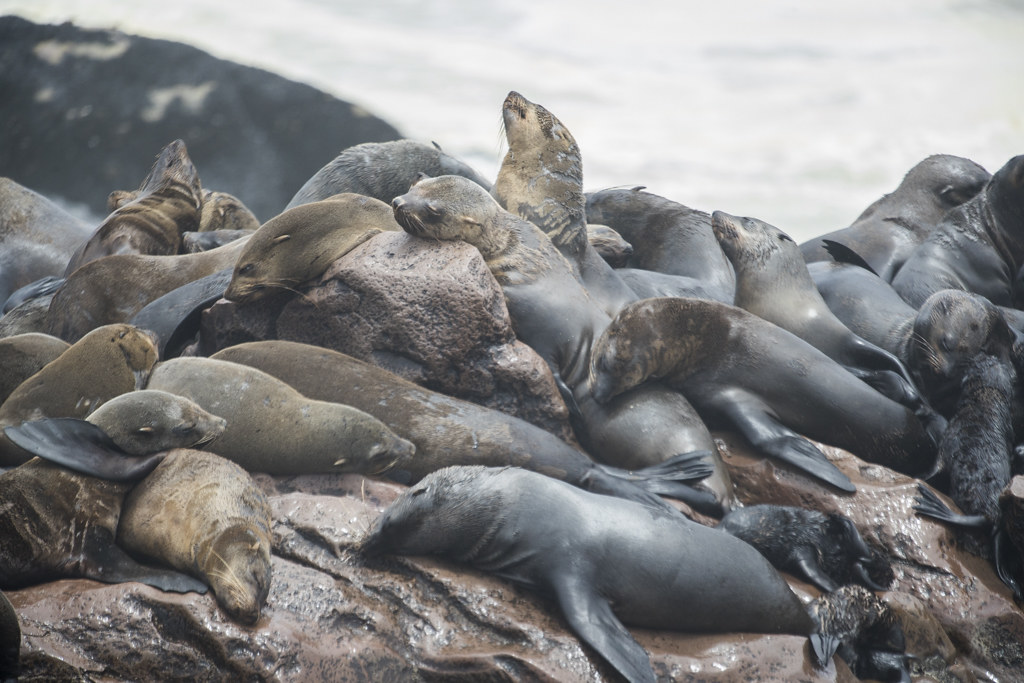
and found a stretch of nearby beach.
Gray's Lark , Namibia's only true endemic perhaps?
No chance but I did get decent views of Red-capped Lark.
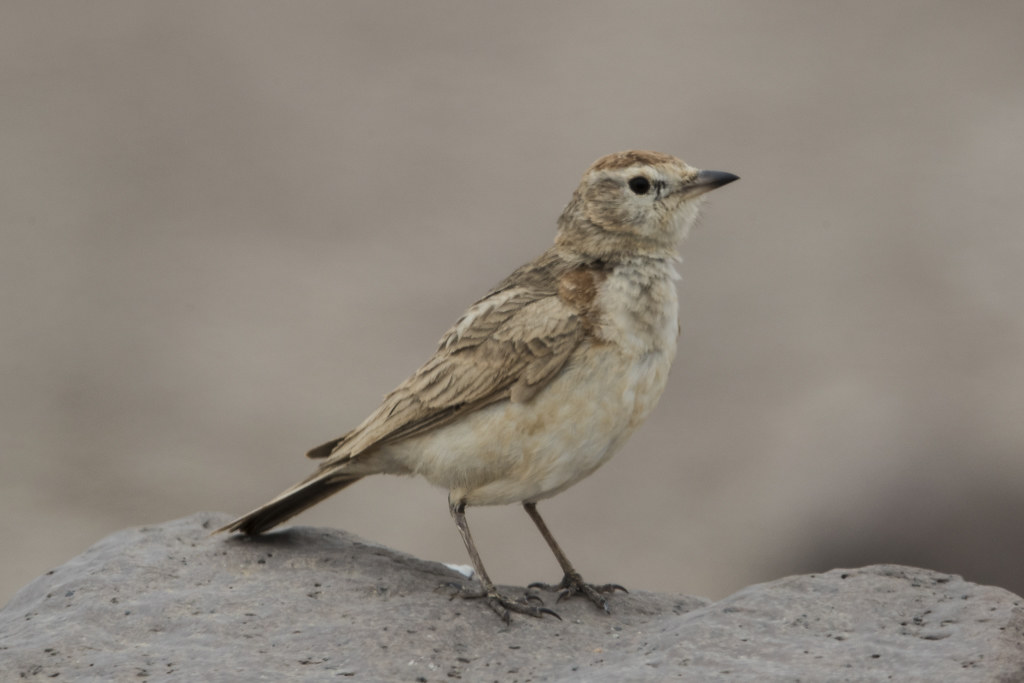
and a new species, White-fronted Plover.
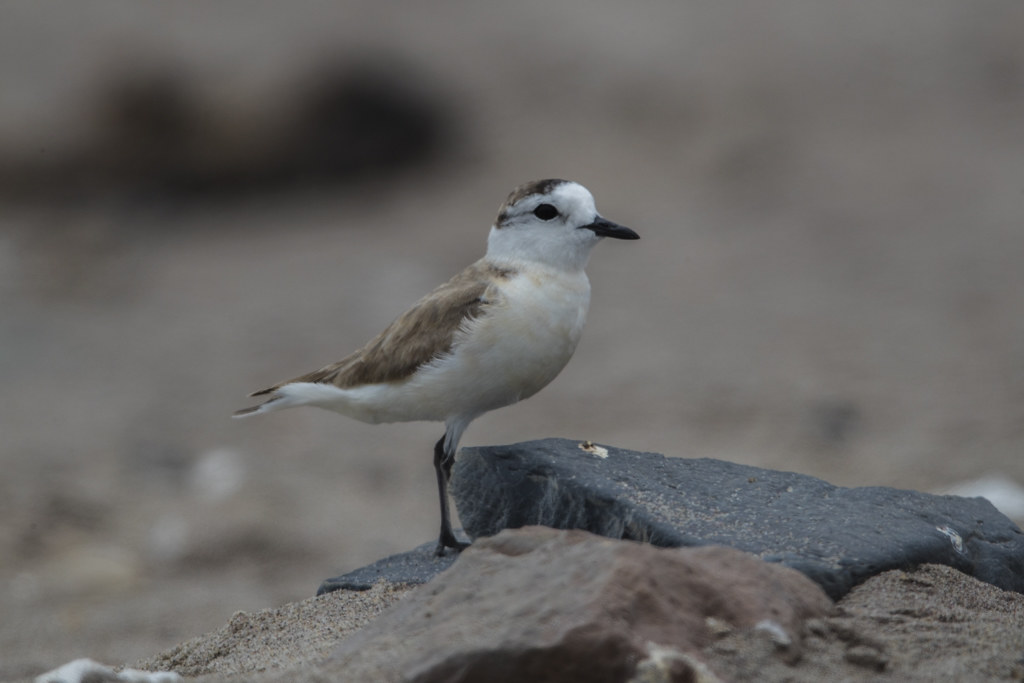
The light had gone quite dull now, not exactly a sea mist but somehow the air was thick.
After an hour at Cape Cross we were ready to return to base. It's a long drive, about 100kms each way and to be honest not really something I would bother with again, particularly as we would see another seal colony much closer to home. I certainly didn't regret not taking a flight along the coast, it was all a bit monotonous. I think the main reason for heading that way is probably the fishing.
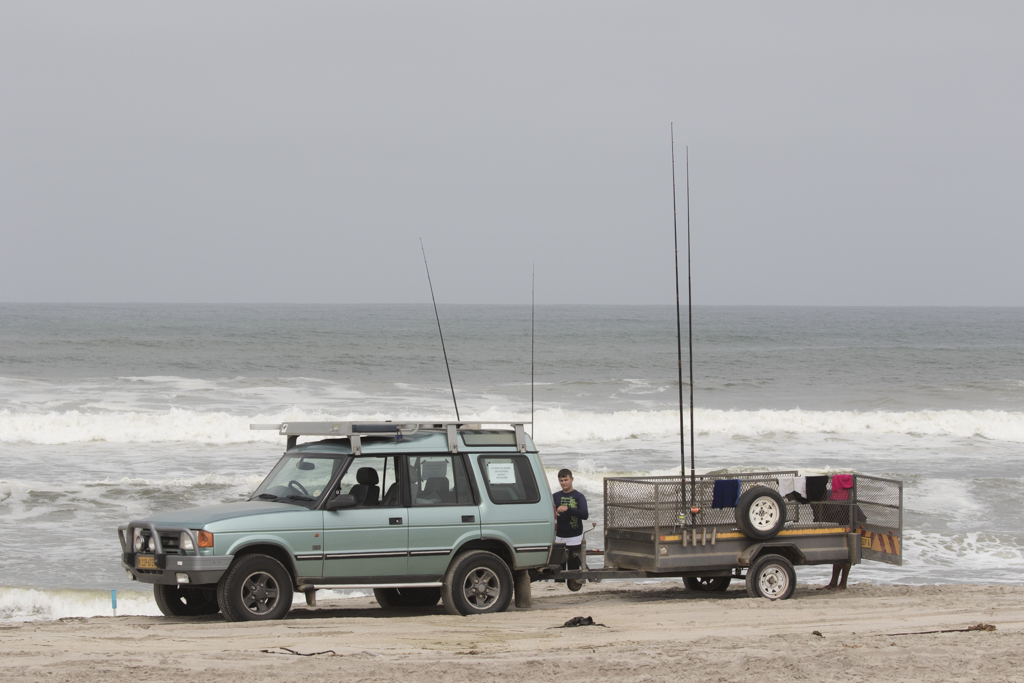
Nearly every vehicle we saw had fishing rods strapped to the car.
Back to base, tonight we were dining at The Jetty restaurant which is at the seaward end of the pier where The Tug is situated. Again good wholesome well prepared food. We both had a trio of differently presented cooked Oysters followed by a seafood on flatbread as a main course.
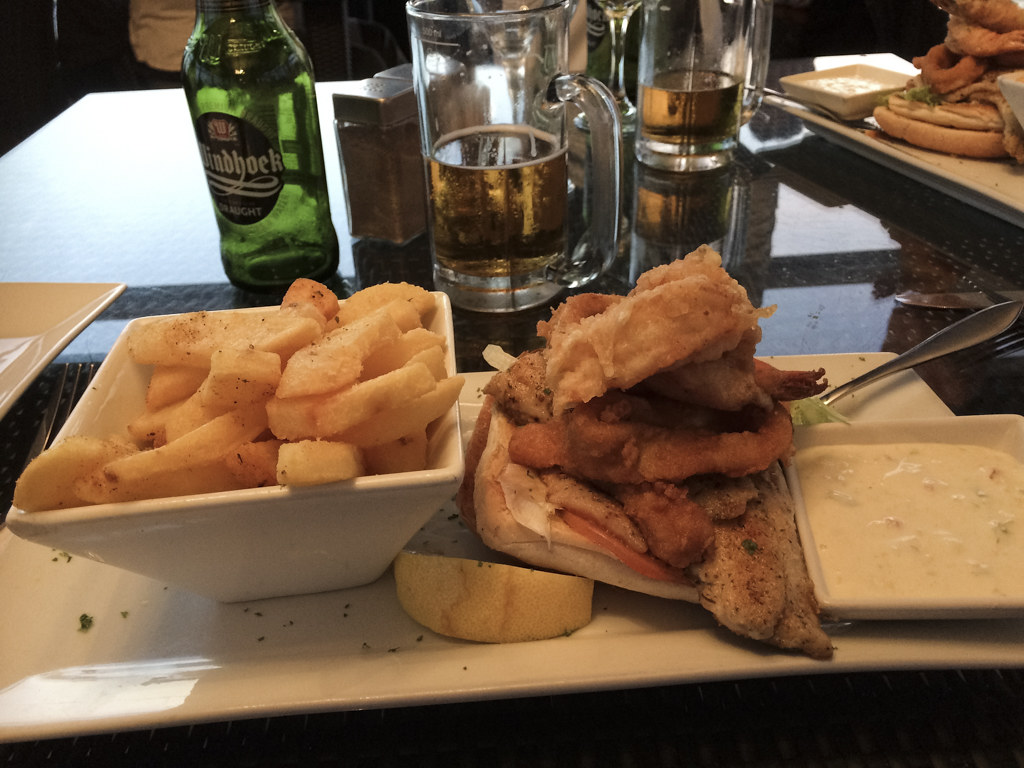
Nothing spectacular but, along with a couple of large beers it cost around 600NR or £40. In the UK the beers alone would be about £16 so we think it good value for the price.
The next morning we headed to Walvis Bay, both to check out the birds and to confirm our booking on the combined boat and dune tour we were due to make the following day. Just as well we did as there was no record of it but they did have room for us.
Meantime we headed down to the beach were you will find hundreds of Flamingos.

Large numbers feed at the outflow from the promenade so you can get very close for photography.
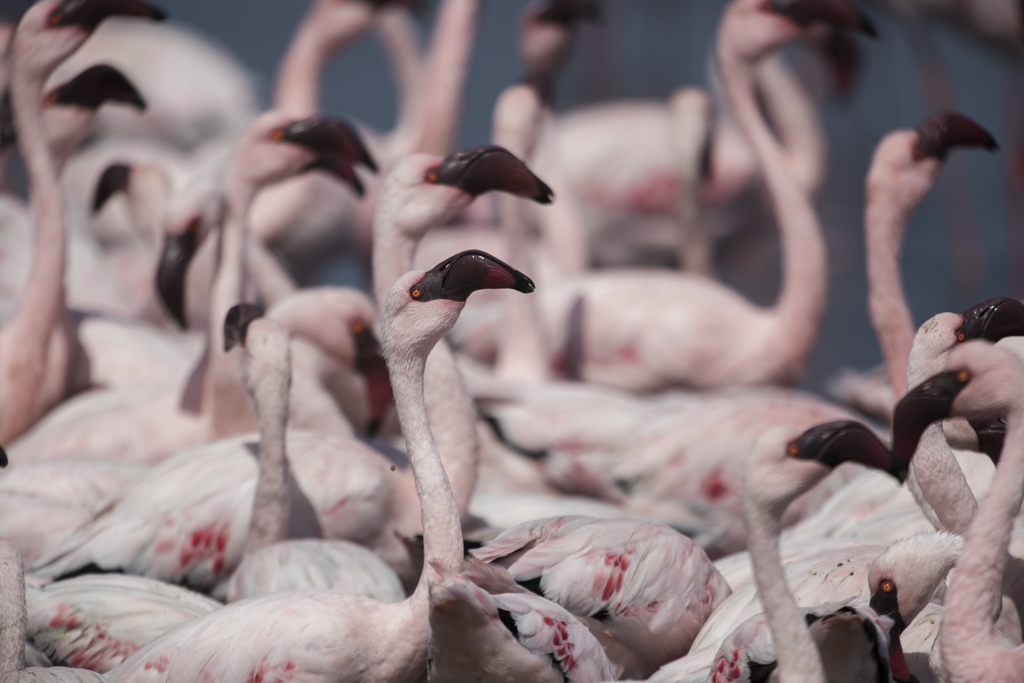
Sitting on the prom is a good spot for flight shots
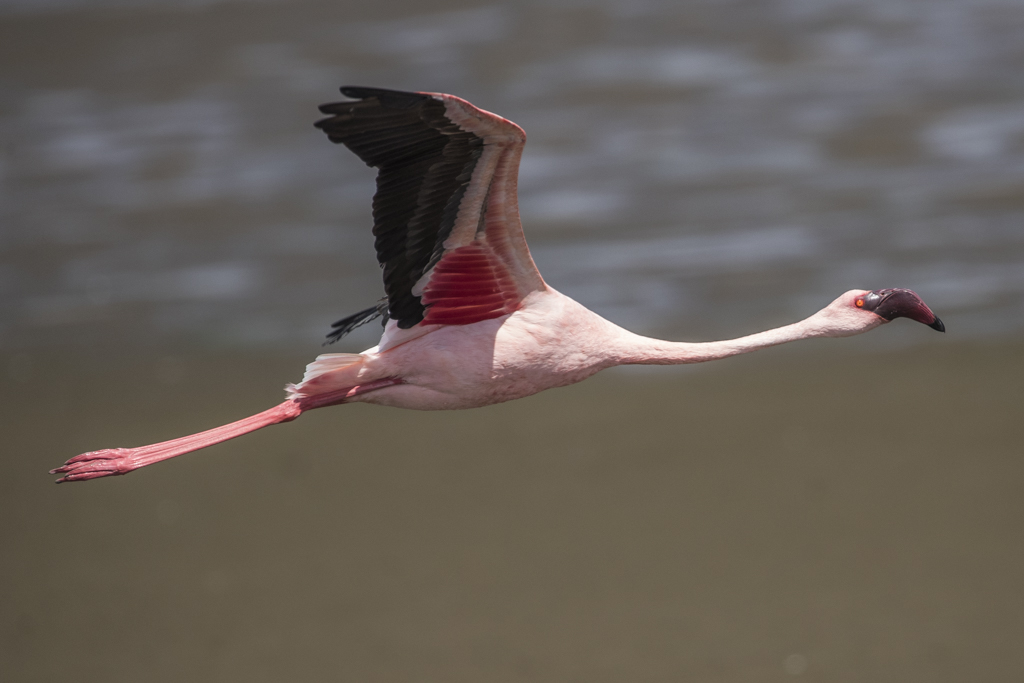
and if you look carefully you should be able to spot a couple of Greater Flamingo in amongst the lesser variety.
This one was actually taken on the road towards the salt works at Pelican Point

A couple of opportunistic Curlew Sandpipers and Sanderling taking advantage of the flamingo's work at disturbing the sand.
Some Cape Teal gave good views from a similar spot

but it seems I upset the locals by parking on the edge of this long straight road as one kayak towing vehicle actually stopped rather than pulling out past me and made a show of his disapproval. There were no signs to say you can't though!
It was low tide though so unfortunately most things were a long way out at the waters edge.
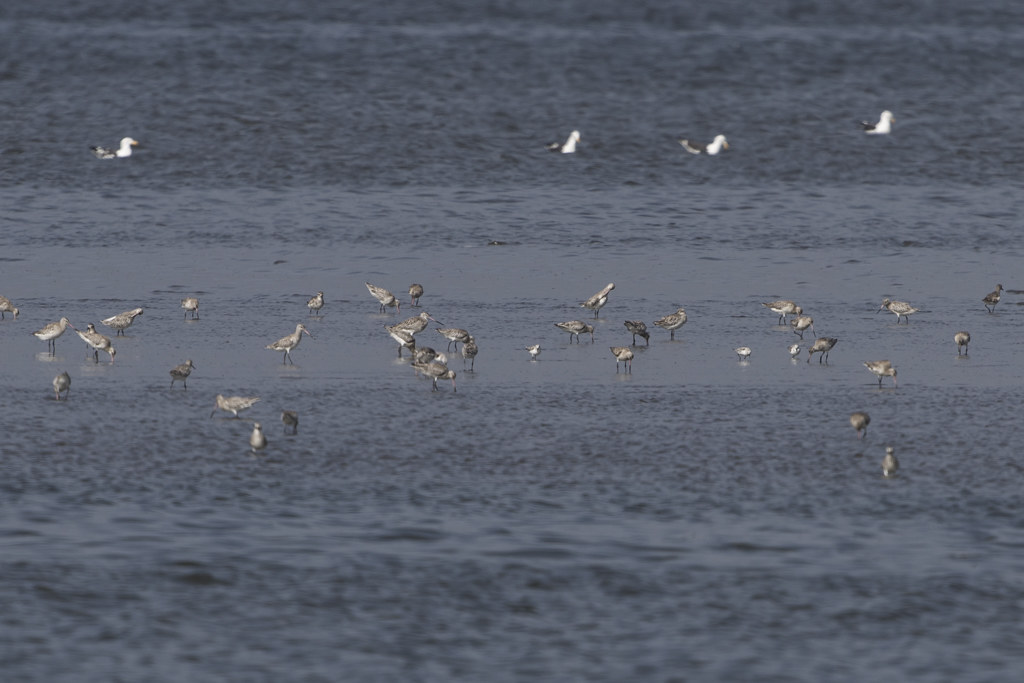
but there were a couple of exceptions besides the Flamingo.
A Grey Plover
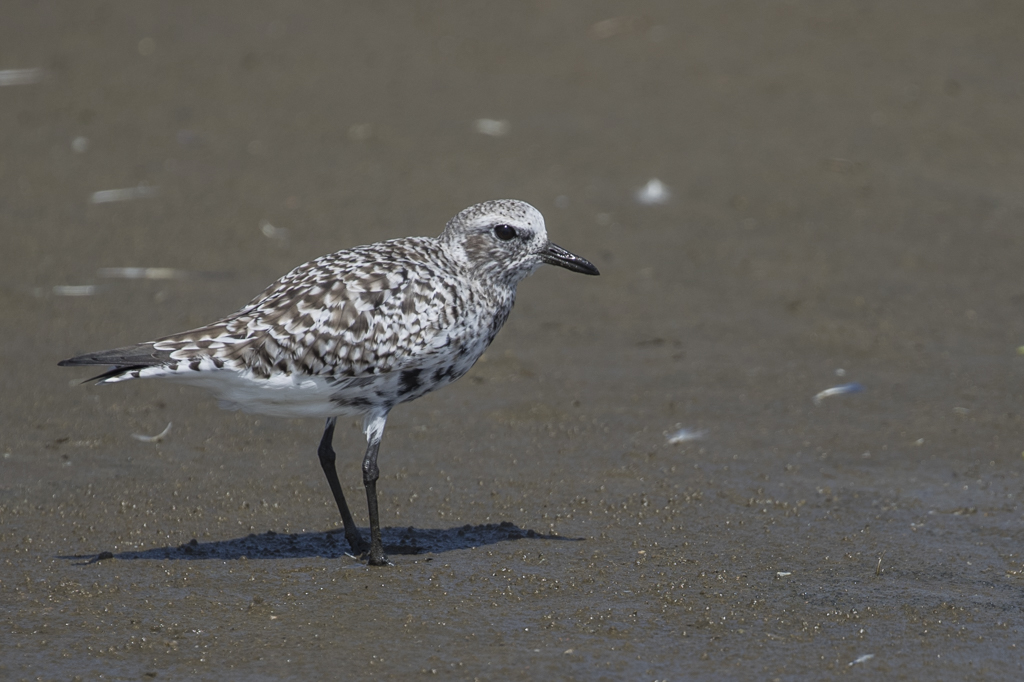
and another "lifer", Hartlaub's Gull
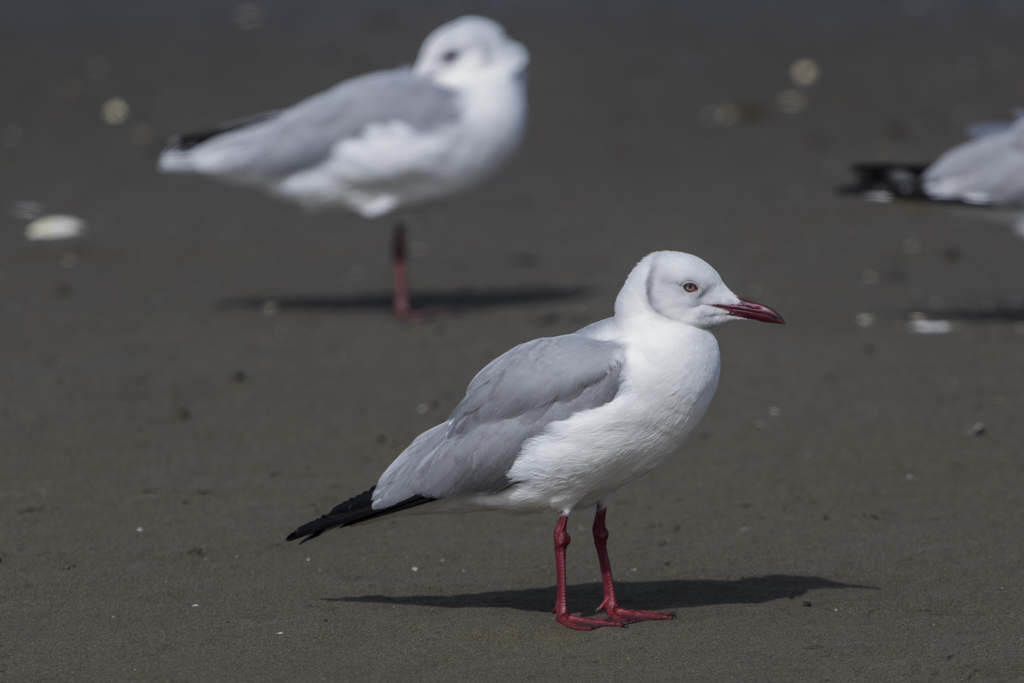
The sun was still shining so we decided to head back to Swakopmund where Claire had some R&R with a book.
Me?
We had taken the back road back home and passed an interesting pool. I went back for another view!
There were a few Lesser Flamingo
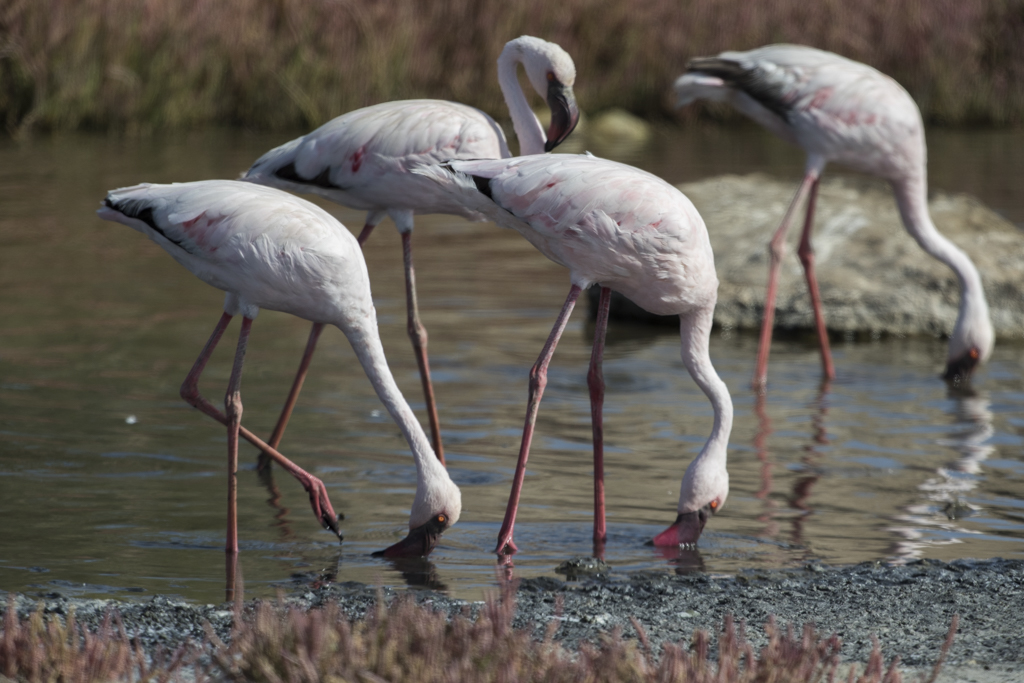
Some close up Avocet
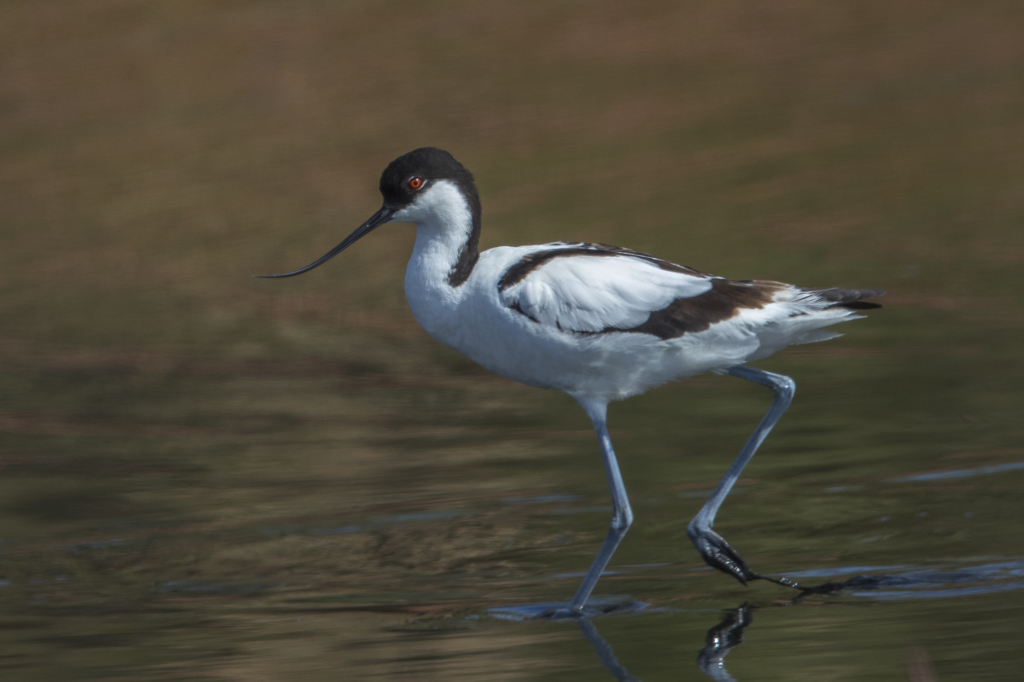
and a few small waders but the heat distortions proving difficult for photographing them, all of which I'd seen elsewhere so i just concentrated on the bigger species.
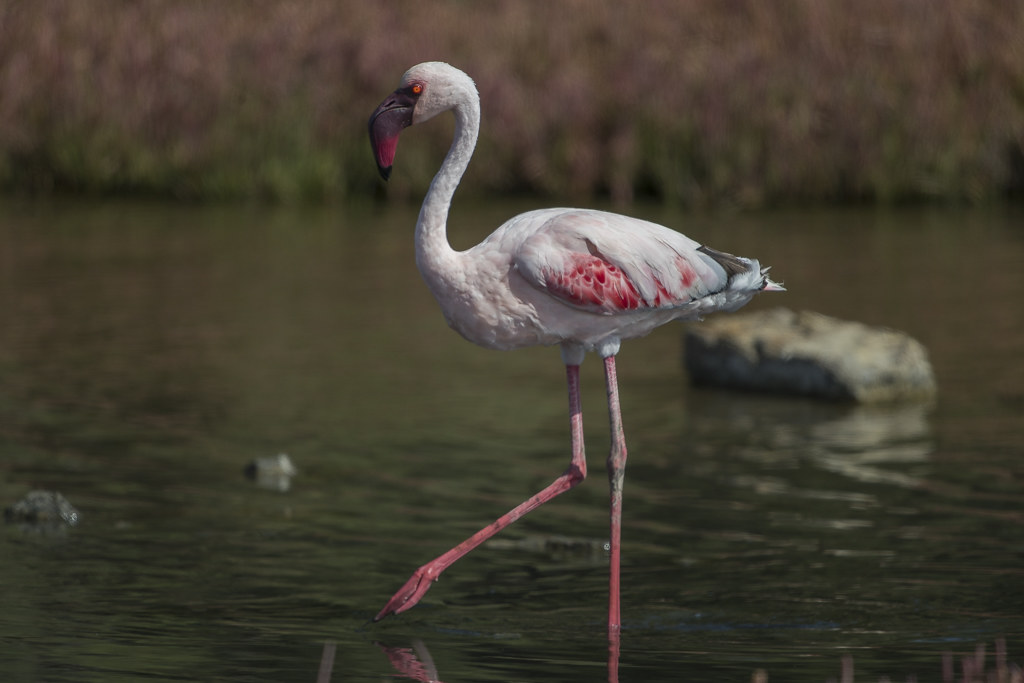
Back to base, tonight we were dining at The Wreck restaurant which is conveniently within walking distance of Villa Sohrada. It was very smart too. Great food, superb sea views excellent service and no more expensive than elsewhere either.
Dover Sole with Mussels. Yum!
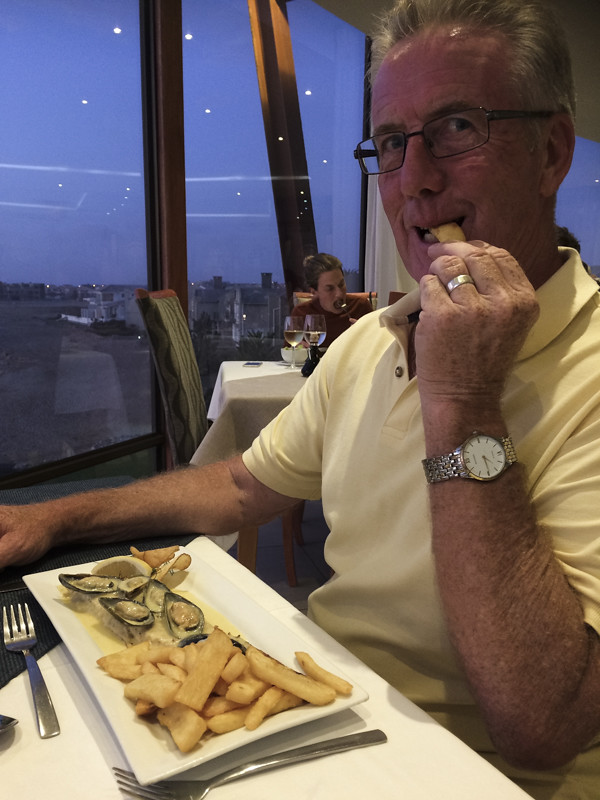
and Claire had a steak.

We decided to book the following night too. No issues with driving that way!
T.B.C.
This time though we stopped just the once when I spotted a Black-chested Snake Eagle by the roadside.

We eventually picked up the tar road of the B2 and arrived at our accommodation in Swakopmund early afternoon.
And the sun was still shining!
We might not have had a pool but the accommodation choice was excellent. We had chosen a self catering apartment at Villa Sohrada in the suburbs of Swakopmund. The hosts live in one house and rent out the apartments in the one next door. We actually stayed in what appeared to be a garage conversion and very comfortable it was too.

We were greeted with a fruit bowl, tea, coffee, biscuits etc which was all unexpected. Had we wanted to we could have cooked evening meals there too as the kitchen area was equipped with enough to do so but we were only interested in trying the local restaurants.

One big benefit was there was an excellent internet connection too, that made a change!

All this for just £40 or 675NR.
That meant that even including dining out it was the least expensive place we stayed.
A drive in to town and the tourist information centre followed and we picked up leaflets on suggested activities in and around Swakopmund. There is certainly plenty of choice! We had already asked our accomodation hosts to book the recommended boat/dune tour trip and that was one day accounted for, we just had to fill the rest. Back at Villa Sohrada I rang a few options. We decided the 2 hour flight in a small plane was too expensive for us at £500, and besides, Claire hates flying so I think she was relieved to find out how much it cost. I tried to book in for a Living Desert tour but they were all fully booked for the next couple of days but I did manage to get a booking for the last day in Swakop, although not my first choice provider. Tomorrow then, it looked like Cape Cross and the Fur seal colony was the best option.
Tonight though we were booked in to The Tug , a well recommended restaurant in the centre of town, a 10 minute drive away.

The slightly odd looking building is built around part of a Tug boat, we were lucky to get a table with a sea view and you can watch the sun go down over the horizon and see hundreds of Cormorants and Flamingo's heading to their roosting spots.
The food is inexpensive by UK standards and very palatable too. I would have preferred mushy peas to salad with my fish and chips though!
Once again. our second day in Swakopmund had the sun shining through and off we headed north to Cape Cross.
It's a longer drive than you think and driving through the arid desert scenery does get a bit boring after a while.

The light was a strange mix too and as you can see in the photo, heat haze made photography difficult again.
There were the odd distractions though, a wrecked boat is probably on everyone's stopping place.

The Skeleton Coast gets it's name from the number of shipwrecks and perhaps there is evidence of more further north but this was the only one we saw.
Arriving at Cape Cross you pay the same entry fee as Etosha. 80NRpp plus 10NR for the car.
We had already read about the smell from the seals and in fairness it wasn't that bad however, once you have seen one seal

I don't really need to see this many!

In fairness, quite a sight though.
There are lots of young ones but the mortality rate is around 20%,

and the smell comes from the rotting carcasses.
Opportunistic Kelp Gulls hang around for an easy meal and the easy entry point is the trough the eye sockets. All a bit gruesome.

I decided to leave the seal to their slumber

and found a stretch of nearby beach.
Gray's Lark , Namibia's only true endemic perhaps?
No chance but I did get decent views of Red-capped Lark.

and a new species, White-fronted Plover.

The light had gone quite dull now, not exactly a sea mist but somehow the air was thick.
After an hour at Cape Cross we were ready to return to base. It's a long drive, about 100kms each way and to be honest not really something I would bother with again, particularly as we would see another seal colony much closer to home. I certainly didn't regret not taking a flight along the coast, it was all a bit monotonous. I think the main reason for heading that way is probably the fishing.

Nearly every vehicle we saw had fishing rods strapped to the car.
Back to base, tonight we were dining at The Jetty restaurant which is at the seaward end of the pier where The Tug is situated. Again good wholesome well prepared food. We both had a trio of differently presented cooked Oysters followed by a seafood on flatbread as a main course.

Nothing spectacular but, along with a couple of large beers it cost around 600NR or £40. In the UK the beers alone would be about £16 so we think it good value for the price.
The next morning we headed to Walvis Bay, both to check out the birds and to confirm our booking on the combined boat and dune tour we were due to make the following day. Just as well we did as there was no record of it but they did have room for us.
Meantime we headed down to the beach were you will find hundreds of Flamingos.

Large numbers feed at the outflow from the promenade so you can get very close for photography.

Sitting on the prom is a good spot for flight shots

and if you look carefully you should be able to spot a couple of Greater Flamingo in amongst the lesser variety.
This one was actually taken on the road towards the salt works at Pelican Point

A couple of opportunistic Curlew Sandpipers and Sanderling taking advantage of the flamingo's work at disturbing the sand.
Some Cape Teal gave good views from a similar spot

but it seems I upset the locals by parking on the edge of this long straight road as one kayak towing vehicle actually stopped rather than pulling out past me and made a show of his disapproval. There were no signs to say you can't though!
It was low tide though so unfortunately most things were a long way out at the waters edge.

but there were a couple of exceptions besides the Flamingo.
A Grey Plover

and another "lifer", Hartlaub's Gull

The sun was still shining so we decided to head back to Swakopmund where Claire had some R&R with a book.
Me?
We had taken the back road back home and passed an interesting pool. I went back for another view!
There were a few Lesser Flamingo

Some close up Avocet

and a few small waders but the heat distortions proving difficult for photographing them, all of which I'd seen elsewhere so i just concentrated on the bigger species.

Back to base, tonight we were dining at The Wreck restaurant which is conveniently within walking distance of Villa Sohrada. It was very smart too. Great food, superb sea views excellent service and no more expensive than elsewhere either.
Dover Sole with Mussels. Yum!

and Claire had a steak.

We decided to book the following night too. No issues with driving that way!
T.B.C.
Subscribe to:
Posts (Atom)